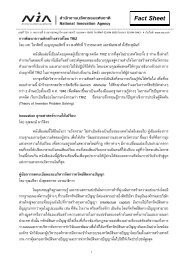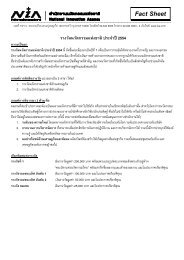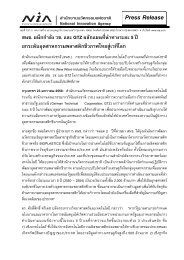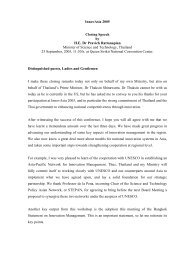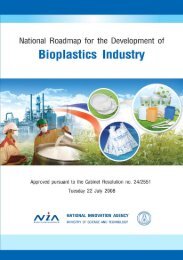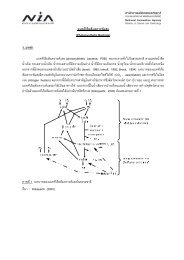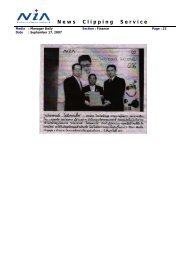บทที่5 การสรางงานวิจัยและการพัฒนาเทคโนโลยี
บทที่5 การสรางงานวิจัยและการพัฒนาเทคโนโลยี
บทที่5 การสรางงานวิจัยและการพัฒนาเทคโนโลยี
Create successful ePaper yourself
Turn your PDF publications into a flip-book with our unique Google optimized e-Paper software.
บทที่ 5 การสรางงานวิจัยและการพัฒนาเทคโนโลยีตนน้ํา-กลางน้ําในประเทศไทย5.1 บทนําเมื่อเปรียบเทียบกระบวนการผลิตทางชีวภาพ (Bio-based process) กับกระบวนการทางปโตรเคมี (Petrobasedprocess) เราจะพบวา กระบวนการผลิตทางชีวภาพมีตนทุนวัตถุดิบที่ต่ํากวา แตมีตนทุนในสวนของกระบวนการสูงกวากระบวนการทางปโตรเคมี ในการที่จะเพิ่มศักยภาพทางการตลาดของกระบวนการทางชีวภาพใหทัดเทียมกับกระบวนการทางปโตรเคมีและสามารถทดแทนกระบวนการทางปโตรเคมีไดนั้น จําเปนตองวิเคราะหขอมูลการผลิตและการตลาดของวัตถุดิบทางการเกษตร มีการพัฒนากระบวนการในเทคโนโลยีตนน้ําในการเปลี่ยนผลผลิตทางการเกษตรใหเปนน้ําตาลเพื่อผลิตเปนวัตถุดิบสําหรับพลาสติกชีวภาพมีองคความรูพื้นฐานทางชีวเคมีและเทคโนโลยีดานการหมักและการแยกบริสุทธิ์ผลิตภัณฑเทคโนโลยีตนน้ํา-กลางน้ํานั้นสามารถแบงออกเปน 3 กลุมใหญ ไดแก (1) กลุมการเตรียมวัตถุดิบทางการเกษตร (2) กลุมเทคโนโลยีชีวภาพ (ประกอบดวยงานวิจัยหลักเกี่ยวกับกระบวนการหมักและการแยกบริสุทธิ์ผลิตภัณฑจากกระบวนการหมัก) และ (3) กลุมเทคโนโลยีทางเคมี ซึ่งรวมถึงการสังเคราะหมอนอเมอรบางชนิด ที่ไดมาจากกระบวนการทางเคมีในการผลิตดวย ตลอดจนการนํามอนอเมอรที่ไดมาทําปฏิกิริยาพอลิเมอไรเซชั่น(polymerization) ใหเปนโฮโมพอลิเมอรหรือโคพอลิเมอร เพื่อใหพลาสติกยอยสลายมีสมบัติเปนที่ตองการสําหรับการนําไปใชงานแตละประเภท5.2 งานวิจัยที่เกี่ยวของกับเทคโนโลยีตนน้ํา-กลางน้ําเมื่อพิจารณาถึงความพรอมของประเทศไทยเพื่อปรับตัวรับกับกระแสโลกในเรื่องการหาพลังงานทดแทน จะเห็นไดวาประเทศไทยมีเงื่อนไขที่เอื้อตอการใชวัตถุดิบมวลชีวภาพดวยความเปนประเทศเกษตรกรรม วัตถุดิบมวลชีวภาพที่สําคัญและมีความเปนไปไดสูงไดแก มันสําปะหลัง มีกําลังการผลิตคิดเปนพื้นที่เก็บเกี่ยวมากถึง 6,176,376ไร/ป สามารถคิดเปนผลผลิตหัวมันสําปะหลังสดประมาณ 20 ลานตัน/ป1 และเปนแหลงแปงที่ใหปริมาณแปงสูงกวาพืชชนิดอื่น เชน ขาวโพด ขาว ขาวสาลี ฯลฯ (ปริมาณแปงโดยน้ําหนักแหงคิดเปน รอยละ 72 ในมันสําปะหลัง และ รอยละ62 ในขาวโพด) รวมทั้งมีปริมาณเสนใยและสิ่งเจือปนอื่นนอย (ปริมาณเสนใยโดยน้ําหนักแหงคิดเปนรอยละ 3.73 ในมันสําปะหลัง และรอยละ 9.20 ในขาวโพด) 2,3 กระบวนการผลิตพลาสติกยอยสลายไดทางชีวภาพโดยเนนที่วัตถุดิบจําพวกแปงนั้น จําเปนตองคํานึงถึงความพรอมของเทคโนโลยีตนน้ํา-กลางน้ํา ซึ่งครอบคลุมประเด็นตางๆ ดังนี้การเตรียมวัตถุดิบที่มุงเปาหมายทั้งในเชิงคุณภาพและปริมาณ• การปลูก การเก็บเกี่ยว และการขนสง• การปรับปรุงสายพันธุพืช1 พื้นที่เก็บเกี่ยวผลผลิตของพืชของไทย จําแนกตามขนาดพื้นที่, สํานักงานเศรษฐกิจการเกษตร (2546)2 J.W.Schroeder, Corn gluten feed, composition, storage, handling, feeding, and value, www.ag.ndsu.edu/pubs/ansci/dairy/as1127.pdf3 Establishment of a cassava starch factory, FAO corporate document repository, www.fao.org/docrep/X5032E/x5032E05.htm
แผนที่นําทางการพัฒนาอุตสาหกรรมพลาสติกชีวภาพไทย จัดทําโดย สํานักงานนวัตกรรมแหงชาติ- เพื่อใหไดสายพันธุพืชที่มีความแข็งแรง ทนกับสภาพแวดลอมในประเทศไดดี และมีผลผลิต/ไรสูง- เพื่อใหไดมอนอเมอรจากการเก็บเกี่ยวผลผลิตพืชโดยตรง ทําไดโดยการปรับปรุงพันธุกรรมพืชโดยตัดตอกลุมยีนของจุลินทรียที่เกี่ยวของกับการสรางมอนอเมอรเขาไปในสายพันธุกรรมของพืช (Transgenicplant)• การแปรรูปแปงเปนน้ําตาล• การแปรรูปเศษวัตถุดิบทางการเกษตรและของเสียเปนน้ําตาลการผลิตมอนอเมอร• เทคโนโลยีการหมัก- การคัดเลือกสายพันธุจุลินทรียเพื่อผลิตมอนอเมอรจากแปง/น้ําตาล- การปรับปรุงสายพันธุจุลินทรียโดยวิธีทางพันธุวิศวกรรม (Genetic engineering) และ/หรือวิธีทางวิศวกรรมเมตาบอลิซึม (Metabolic engineering)- การปรับปรุงกระบวนการ (Process engineering)• เทคโนโลยีการสังเคราะหทางเคมี- การปรับปรุงวิธีการสังเคราะห- การคัดเลือกตัวเรงปฏิกิริยาการแยกบริสุทธิ์มอนอเมอร• การออกแบบกระบวนการ (Downstream process design)• การปรับปรุงเทคนิคการแยกบริสุทธิ์ผลิตภัณฑการสังเคราะหพลาสติกยอยสลายไดทางชีวภาพ• การปรับปรุงวิธีการสังเคราะห• การปรับปรุงสมบัติของพลาสติกยอยสลายไดทางชีวภาพ โดยวิธีโคพอลิเมอไรเซชั่น• การออกแบบกระบวนการผลิตในระดับอุตสาหกรรม5.3 ตนแบบงานวิจัยและการพัฒนาเทคโนโลยี (กรณีศึกษาจากตางประเทศ)ภาพรวมทิศทางงานวิจัย และการพัฒนาเทคโนโลยีการผลิตพลาสติกยอยสลายไดทางชีวภาพในตางประเทศในกลุมเทคโนโลยีตน-กลางน้ํา จําแนกตามเทคโนโลยีการเปลี่ยนแปงเปนน้ําตาล และชนิดของพลาสติกยอยสลายไดแสดงไวในตาราง 5.1 ถึง 5.5ตัวอยางผลงานวิจัยในรูปสิทธิบัตรและเอกสารตีพิมพวิชาการที่เกี่ยวของกับการสกัด แยก ทําใหบริสุทธิ์ และแปรรูปแปง เซลลูโลส และเฮมิเซลลูโลสในวัตถุดิบทางการเกษตรแสดงไวในตารางที่ 5.1 จะเห็นไดวาสิทธิบัตรและงานวิจัยในตางประเทศในชวง 10 ปที่ผานมาสวนใหญมุงประเด็นไปที่ความพยายามในการประยุกตเพื่อนําเซลลูโลส5-2
แผนที่นําทางการพัฒนาอุตสาหกรรมพลาสติกชีวภาพไทย จัดทําโดย สํานักงานนวัตกรรมแหงชาติเฮมิเซลลูโลส และลิกนินซึ่งเปนสวนประกอบหลักนอกเหนือจากแปงที่มีอยูในวัตถุดิบทางการเกษตรมาใชเปนวัตถุดิบตั้งตนในกระบวนการทางชีวภาพตารางที่ 5.2 ไดประมวลผลงานวิจัยในรูปสิทธิบัตรและเอกสารตีพิมพวิชาการรวมทั้งทิศทางงานวิจัยในตางประเทศในชวง 8 ปที่ผานมา ซึ่งจะเห็นไดวาประเด็นงานวิจัยมุงไปที่การพัฒนากระบวนการหมักและเทคนิคการแยกบริสุทธิ์กรดแลคติก โดยสิทธิบัตรและงานวิจัยทีเกี่ยวของกับกระบวนการหมัก เนนการนําเซลลูโลส และ/หรือเศษวัตถุดิบทางการเกษตรมาใชเปนวัตถุดิบ การคัดเลือกจุลินทรียเพื่อเพิ่มประสิทธิภาพของกระบวนการแยกบริสุทธิ์นอกจากนี้ยังมีการพัฒนาเทคนิคตางๆ เชน extraction ultrafiltration หรือ electrodialysis เพื่อใชในการแยกบริสุทธิ์กรดแลคติกดวยตัวอยางผลงานวิจัยในรูปสิทธิบัตรและเอกสารตีพิมพวิชาการในตางประเทศในชวง 9 ปที่ผานมาที่เกี่ยวของกับเทคโนโลยีตน-กลางน้ําสําหรับการผลิต PHAs (ตารางที่ 5.3) แสดงใหเห็นถึงทิศทางงานวิจัยไดวาประเด็นงานวิจัยสวนใหญมุงไปที่การใชเทคนิคทางพันธุวิศวกรรมเพื่อปรับปรุงจุลินทรียเพื่อเพิ่มผลผลิตและปรับปรุงสมบัติของ PHAsใหไดตามตองการ เทคนิคการตัดตอทางพันธุกรรมไปในสารพันธุกรรมของพืชทําใหพืชผลิต PHAs เปนงานวิจัยใหมที่กําลังเริ่มไดรับความสนใจตัวอยางผลงานวิจัยในรูปสิทธิบัตรและเอกสารตีพิมพวิชาการที่เกี่ยวของกับเทคโนโลยีตน-กลางน้ําสําหรับการผลิต PDO ในตางประเทศ (ตารางที่ 5.4) แสดงถึงทิศทางงานวิจัยในชวง 13 ปที่ผานมา จากตารางจะเห็นไดวาประเด็นงานวิจัยสวนใหญมุงไปที่การใชเทคนิคการตัดตอทางพันธุวิศวกรรมเพื่อปรับปรุงจุลินทรียเพื่อเพิ่มผลผลิตของPDOตารางที่ 5.5 แสดงถึงทิศทางงานวิจัยในตางประเทศจากตัวอยางผลงานวิจัยในรูปเอกสารตีพิมพวิชาการที่เกี่ยวของกับเทคโนโลยีตน-กลางน้ําสําหรับการผลิต PBS/PBSA/PBAT จากตารางจะเห็นไดวาประเด็นงานวิจัยสวนใหญมุงไปที่การใชเทคนิคการตัดตอทางพันธุวิศวกรรมเพื่อปรับปรุงจุลินทรียเพื่อเพิ่มผลผลิตของ 2,3-butanediol และการผลิตกรดซัคซินิกจากกระบวนการหมัก การใชเทคนิค Biotransformation เพื่อผลิต 2,3-butanediol5-3
แผนที่นําทางการพัฒนาอุตสาหกรรมพลาสติกชีวภาพไทย จัดทําโดย สํานักงานนวัตกรรมแหงชาติตารางที่ 5.1 สิทธิบัตร/งานวิจัยที่เกี่ยวของกับการสกัดแยก แปรรูปแปง เซลลูโลส และเฮมิเซลลูโลสในวัตถุดิบทางการเกษตรประเทศ รายละเอียด เจาของผลงาน/ผูวิจัยหลักTransgenic plants containing ligninase and cellulase which degrade lignin and cellulose toBoard of Trustees of Michiganfermentable sugarsState UniversityUnited States Patent: 7,049,485The transgenic plants comprise ligninase and cellulase genes from microbes operably linked to a DNA encoding a signal(2006)peptide which targets the fusion polypeptide produced therefrom to an organelle of the plant, in particular the chloroplasts.When the transgenic plants are harvested, the plants are ground to release the ligninase and cellulase which then degradethe lignin and cellulose of the transgenic plants to produce the fermentable sugars.สหรัฐอเมริกาHeterologous expression of an Aspergillus kawachi acid-stable alpha amylase and applications ingranular starch hydrolysisThe present invention relates to a one-step method for producing an alcohol which comprises contacting a granular starchsubstrate with an acid-stable alpha amylase (asAA) having granular starch hydrolyzing (GSH) activity and a glucoamylase(GA) in a fermentation step which also comprises ethanologenic microorganisms at a temperature of 25-40°C to obtain afermentation broth having 5 to 20% ethanol.Methods and compositions for simultaneous saccharification and fermentationThe invention provides recombinant host cells containing one or more genes encoding endoglucanses which are capable ofthe synergistic degradation of oligosaccharides. Preferred host cells of the invention are ethanologenic and capable ofcarrying out simultaneous saccharification and fermentation resulting in the production of ethanol from complex cellulosesubstrates.Methods of producing compounds from plant materialThe invention includes methods of processing plant material. The filtrate containing starch, starch fragments, hemicellulose,and fragments of hemicellulose is treated to form linear poly-alcohols which are then cleaved to produce one or more ofglycerol, ethylene glycol, lactic acid and propylene glycol. The invention also includes a method of producing free and/orcomplexed sterols and stanols from plant material.Genencor International, Inc.United States Patent: 7,037,704(2006)University of Florida ResearchFoundation, Inc.United States Patent: 7,026,152(2006)Archer Daniels Midland CompanyBattelle Memorial InstituteUnited States Patent: 6,982,328(2006)5-4
แผนที่นําทางการพัฒนาอุตสาหกรรมพลาสติกชีวภาพไทย จัดทําโดย สํานักงานนวัตกรรมแหงชาติประเทศ รายละเอียด เจาของผลงาน/ผูวิจัยหลักOptimizing dilute acid hydrolysis of hemicellulose in a nitrogen-rich cellulosic material - dairy Corresponding author: W. LiaomanureBioresource Technology, 2004, 94,33-41Effective dilute acid hydrolysis of dairy manure which contains roughly 12% hemicellulose on a dry matter basis canproduce a variety of mono-sugars such as arabinose, xylose and galactose, as well as to further benefit utilization ofcellulose in the manure. To enhance the effectiveness of this dilute acid hydrolysis, the effect of manure nitrogen contentสหรัฐอเมริกาwas studied because some reactions such as the browning reaction between amino acids and reducing sugars and acid–base reactions involving ammonia and acid interfere with the hydrolysis. Two dairy manure samples were used to study thisnitrogen effect; the original manure and the pretreated manure derived from a solid/liquid separation pretreatment.เดนมารกชิลีFeatures of promising technologies for pretreatment of lignocellulosic biomassMany factors hinder the enzymatic digestibility of cellulose present in lignocellulosic biomass. The pretreatment causingphysical and/or chemical changes in the plant biomass is used to alter or remove impediments to hydrolysis in order toimprove the rate of enzyme hydrolysis and increase yields of fermentable sugars from cellulose or hemicellulose.Method for production of maltose and a limit dextrin, the limit dextrin, and use of the limit dextrinRaw starch is treated with the amylase with the enzyme classification EC 3.21.133 below the gelatinization temperature,whereafter the maltose and the limit dextrin are recovered. The method is simple and cheap and gives rise to a maltose ofhigh purity and to a cheap limit dextrin useable as a fat replacer in foods.Starch conversion processThe present invention relates to a starch conversion process of the type which includes a debranching step wherein anisoamylase being active at the process conditions prevailing is used for debranching the starch and to the use ofthermostable isoamylases for starch conversion. The isolated isoamylase is obtained from fermentation of host cellcontaining cloned DNA sequences encoding isoamylases derived from a strain of Rhodothermus or Sulfolobus.Grain processing method and transgenic plants useful thereinExpression of transgenic thioredoxin and/or thioredoxin reductase in corn and soybeans and the use of thioredoxin in grainprocessing, e.g., wet milling, provide an alternative method for reducing the disulfide bonds in seed proteins during or priorto industrial processing. The invention therefore provides grains with altered storage protein quality as well as grains thatperform qualitatively differently from normal grain during industrial processing or animal digestion (both referred tosubsequently as processing).Corresponding author: M. LadischBioresource Technology, 2005, 96,673-686Novozymes A/SUnited States Patent: RE39,005(2006)Novozymes AISUnited States Patent: 6,448,049(2002)Syngenta Participations AGUnited States Patent: 6,531,648(2003)5-5
แผนที่นําทางการพัฒนาอุตสาหกรรมพลาสติกชีวภาพไทย จัดทําโดย สํานักงานนวัตกรรมแหงชาติประเทศ รายละเอียด เจาของผลงาน/ผูวิจัยหลักStarch hydrolysis under low water conditions: A conceptual process designA process concept is presented for the hydrolysis of starch to glucose in highly concentrated systems. Depending on theCorresponding author: A.J. Vander Gootเนเธอรแลนด moisture content, the process consists of two or three stages. The two-stage process comprises combined thermal and Journal of Food Engineering,enzymatic liquefaction, followed by enzymatic saccharification. The three-stage process starts with shear induced melting of 2006, 75, 178-186starch, followed by enzymatic liquefaction and saccharification.รัสเซียสหราชอาณาจักรโปแลนดEvaluation of hydrolysis conditions of cellulosic materials by Penicillium cellulaseThe conditions of hydrolysis of skop (short fiber waste material from the paper industry) and cellolignin (waste of industrialfurfural production) by the cellulase system from Penicillium sp. in a batch reactor have been evaluated. Studies of fedbatchprocess of saccharification of both substrates by three cellulase preparations (from Penicillium sp., Trichoderma reeseiand combined preparations of T. reesei and Aspergillus foetidus) have shown that the highest saccharification activity wasdemonstrated by Penicillium cellulase.Design and operation of an integrated membrane reactor for enzymatic cellulose hydrolysisA purposely built membrane reactor with combined reaction and separation zone in a single piece of equipment was testedfor heterogeneous enzymatic hydrolysis of a hardwood derived cellulosic material. The design and operation features aprocess of simultaneous reaction and in situ removal of products (reducing sugars) in order to reduce the effect of productinhibition on the cellulase enzyme.Saccharification of potato starch in an ultrafiltration reactorEnzyme hydrolysis of maltodextrine by a fungal α-amylase for the production of maltose syrup carried out by asimultaneous use of a stirred tank reactor and a ceramic ultrafiltration membrane with various molecular weight cut-off.In vitro fermentation of new modified starch preparations - changes of microstructure and bacterialend-productsThe fermentation of new preparations of modified starches (wheat, potato, pea) by Bifidobacterium monocultures ormicroflora of rat caecum was evaluated on the basis of changes in the microstructure as well as bacterial basic endproductsin comparison to their initial native starches. The growth and acidifying activity of the selected strains: B.pseudolongum KSI9, B. breve KN14 and B. animalis KS20a1, were higher in fermented modified starches compared to theirnative forms, however lower than those obtained upon glucose as the control.Corresponding author: O. F.CastellanosBioresource Technology, 1995, 52,109-117Corresponding author: Q. GanBiochemical Engineering Journal,2002, 12, 223-229Corresponding author: A.Grześkowiak-PrzyweckaJournal of Food EngineeringArticle in Press, corrected proofCorresponding author: M. Soral-ŚmietanaEnzyme and Microbial TechnologyArticle in Press, Corrected Proof5-6
แผนที่นําทางการพัฒนาอุตสาหกรรมพลาสติกชีวภาพไทย จัดทําโดย สํานักงานนวัตกรรมแหงชาติประเทศ รายละเอียด เจาของผลงาน/ผูวิจัยหลักAdsorption and reuse of cellulases during saccharification of cellulosic materialsCorresponding author: K. SchügerlเยอรมันAdsorption characteristics of cellulases onto cellulosic materials such as potato pulp (waste from potato starch industry) Journal of Biotechnology, 1991,were studied and compared with the adsorption onto Avicel (microcrystalline cellulose). The enzyme loading at which 18, 205-212saturation of substrate occurs correlated with the optimum loading for hydrolysis, thus indicating that the adsorption processcontrols the rate of hydrolysis.บัลแกเรียแอฟริกาใตAn effective method for bioconversion of delignified waste-cellulose fibers from the paper industrywith a cellulase complexAn effective method for production of glucose was developed using enzymatic hydrolysis of waste-cellulose fibers by thecellulase complex from Trichoderma reesei. However, these cellulosic materials are strongly resistant to direct enzymatichydrolysis apparently due to the presence of various chemical substances used in the process of paper production. Thisadhesive envelope around the cellulose fibers was effectively pretreated with 0.25% H 3 PO 4 and after that the free cellulosemass was extensively hydrolyzed by the cellulase complex. The HPLC analyses of the enzyme hydrolysates revealedglucose as the main component as well as some cellobiose and xylose.Hydrolysis of pretreated paper materials by different concentrations of cellulase from PenicilliumfuniculosumPaper materials, filter paper, foolscap paper, newspaper and office paper were incubated with cellulase from P. funiculosum.To increase the extent of glucose formation from the cellulose components, all were treated by homogenization, heat, andultrasonification prior to incubation with different cellulase concentrations.Response surface optimization of enzymatic hydrolysis of maize starch for higher glucoseproductionCrude amylases were prepared from Bacillus subtilis ATCC 23350 and Thermomyces lanuginosus ATCC 58160 under solidstate fermentation. The effect of various process variables was studied for maximum conversion efficiency of maize starchto glucose using crude amylase preparations. Full factorial composite experimental design and response surfacemethodology were used in the design of experiments and analysis of results.Corresponding author: D. KolevBioresource Technology, 2000, 71,1-4Corresponding author: J. P. H. vanWykBioresource Technology, 1999, 69,269-273Corresponding author: A.KunamneniBiochemical Engineering Journal,2005, 27, 179-1905-7
แผนที่นําทางการพัฒนาอุตสาหกรรมพลาสติกชีวภาพไทย จัดทําโดย สํานักงานนวัตกรรมแหงชาติประเทศ รายละเอียด เจาของผลงาน/ผูวิจัยหลักPreparation of immobilized cellulase beads and their application to hydrolysis of cellulosic materials Corresponding author: M.ญี่ปุนCellulase was immobilized on aluminium oxide beads with a polymer matrix by radiation polymerization at low temperature Kumakurausing various monomers. The optimum conditions for the preparation of the immobilized enzyme beads were obtained, and Process Biochemistry, 1997, 32,the characteristics of the immobilized enzyme beads was investigated by repeated batch enzyme reactions.555-559อิหรานA model for the rate of enzymatic hydrolysis of some cellulosic waste materials in heterogeneoussolid–liquid systemsThe enzymatic hydrolysis of some cellulosic waste materials has been studied in a batch stirred reactor at 50 °C. A kineticmodel has been developed for such a process based on the shrinking particle theory and Langmuir isotherm concept. Acomparison between the experimental data for diverse reaction systems and those predicted from the model, demonstratedthe applicability of the latter. In each case the mean absolute deviation was below 5%.Corresponding authors: K.Movagharnejad, M. SohrabiBiochemical Engineering Journal,2003, 14, 1-85-8
แผนที่นําทางการพัฒนาอุตสาหกรรมพลาสติกชีวภาพไทย จัดทําโดย สํานักงานนวัตกรรมแหงชาติตารางที่ 5.2 สิทธิบัตร/งานวิจัยที่เกี่ยวของกับเทคโนโลยีตนน้ํา-กลางน้ําสําหรับการผลิต PLAประเทศ รายละเอียด เจาของผลงาน/ผูวิจัยหลักProduction of chemicals from lignocellulose, biomass or sugarsThe newly isolated organisms, as exemplified by Bacillus sp. strain 17C5, ferment sugars in hemicellulose hydrolysate toL(+)-lactic acid at high yields using a simple salts medium supplemented with 0.5% corn steep liquor. The L(+)-lactateproduct had an optical purity of greater than 99% and comprised 90% of the sugar weight. These organisms, andgenetically modified derivatives thereof, can be used for the conversion of pentose-rich feedstocks such as corn stover,corn fiber, bagasse, rice hulls, rice straw, or other forms of biomass into commodity chemicals such as L(+)-lactic acid.University of Florida ResearchFoundation, Inc.United States Patent: 7,098,009(2006)สหรัฐอเมริกาLactic acid processing; methods; arrangements; and productsLactic acid removal from the mixture by extraction. Extraction processes provide quite selective for the lactic acid, versusother materials (such as amino acids and carbohydrates) in the fermentation mixture. Such high selectivity can beachieved using basic extractants such as trialkylamines, especially relatively insoluble trialkylamines having at least 18carbon atoms, such as Alamine 336.Lactic acid residue containing polymer composition and product having improved stability, andmethod for preparation and use thereofA lactic acid residue containing polymer composition having improved stability is provided by this invention. By providingimproved stability, the composition provides at least one or all of lactide formation stability, molecular weight degradationstability, and color stability. Preferably, the lactic acid residue containing polymer composition includes a polylactidepolymer having a number average molecular weight of between about 25,000 and about 200,000, and between about0.01 wt % and about 2 wt % deactivating agent. Two classes of deactivating agent are described in this application. Thefirst class of deactivating agent includes phosphite antioxidants. The second class includes multifunctional carboxylicacids.Process for isolating lactic acidA process for production and separation and/or recovery of lactic acid from a lactate feed solution. A lactate feed solutionobtained from a fermentation broth is combined with and extracted by a water immiscible trialkyl amine in the presence ofcarbon dioxide. Lactic acid is recovered from the resulting organic phase. Recovered carbonate or bicarbonate from theaqueous phase is recycled to the fermentor and regenerated extractant is preferably recycled for use in the extraction.Cargill, IncorporatedUnited States Patent: 6,534,679(2003)Cargill, IncorporatedUnited States Patent: 6,353,086(2002)Cargill, IncorporatedUnited States Patent: 6,087,532(2000)5-9
แผนที่นําทางการพัฒนาอุตสาหกรรมพลาสติกชีวภาพไทย จัดทําโดย สํานักงานนวัตกรรมแหงชาติประเทศ รายละเอียด เจาของผลงาน/ผูวิจัยหลักProcess for the preparation of 2,3-pentadioneA process for the preparation of purified 2,3-pentanedione from lactate compound which is lactic acid or a lactic acidBoard of Trustees operatingMichigan State Universityสหรัฐอเมริกาester. The process uses elevated temperatures between 250°C and 370°C for heating a support and pressures betweenUnited States Patent: 5,731,4710.1 and 10 MPa to produce the 2,3-pentanedione in a reaction mixture. The lactate compound is converted primarily to(1998)2,3-pentanedione, acrylic acid, and acetaldehyde at the elevated temperatures over the catalyst. The 2,3-pentanedione ispreferably separated from the reaction mixture as an azeotrope with water at about 80°C to 90°C and then cooled toseparate the 2,3-pentanedione from the water.สเปนฝรั่งเศสMonitoring of lactic acid fermentation in culture broth using ultrasonic velocityThe fermentations of several carbohydrates (glucose, galactose and lactose) have been monitored measuring ultrasonicvelocity during the growth of Lactobacillus casei in basal MRS media. A remarkable correlation was found between theultrasonic velocity and the bacterial catabolism. These results could be used to model changes occurring during lacticacid fermentations and show the great potential of this non-invasive technique for monitoring biotechnological processes.Revalorization of hemicellulosic trimming vine shoots hydrolyzates trough continuous productionof lactic acid and biosurfactants by L. pentosusThis work proposes the utilization of trimming vine shoots hydrolyzates by Lactobacillus pentosus for lactic acidemploying continuous culture and the evaluation of biosurfactants production. The treatment of hydrolyzates withsulphuric acid allowed the solubilization of hemicelluloses to give liquors containing 18 g/L xylose, 11.1 g/L glucose,4.3 g/L arabinose and 4 g/L acetic acid. Continuous fermentation of hemicellulosic hydrolyzates gave a Q P = 3.10 g lacticacid/L h and Y P/S = 0.70 g lactic acid/g sugars for a dilution rate of 0.02 h −1 using 10 g/L corn steep liquor and 10 g/Lyeast extract as nutrients. L. pentosus cells were extracted with PBS to evaluate the intracellular biosurfactants.Investigation of nanofiltration as a purification step for lactic acid production processes based onconventional and bipolar electrodialysis operationsNanofiltration was investigated for usability in a specific lactic acid production process based on conventional and bipolarelectrodialysis operations. The commercially available DK nanofiltration membrane was used and performances in termsof lactate/lactic acid recovery rate and purification efficiency are reported. Nanofiltration was able to efficiently removemagnesium and calcium ions from a sodium lactate fermentation broth before its concentration and conversion byelectrodialysis. Maximum impurity rejections and lactate recovery were obtained at maximum transmembrane pressures.Corresponding authors: P. Resa,T. BolumarJournal of Food Engineering,2007, 78, 1083-1091Corresponding authors: A.B.Moldes, J.M. CruzJournal of Food Engineering,2007, 78, 405-412Corresponding author: A.BouchouxSeparation and PurificationTechnologyArticle in Press, Corrected Proof5-10
แผนที่นําทางการพัฒนาอุตสาหกรรมพลาสติกชีวภาพไทย จัดทําโดย สํานักงานนวัตกรรมแหงชาติประเทศ รายละเอียด เจาของผลงาน/ผูวิจัยหลักเยอรมันMethod for producing polylactic acid and corresponding deviceThe invention relates to a method for producing polylactic acid, comprising the steps of obtaining lactic acid from starchyagricultural products by fermentation, ultrapurification of the lactic acid by ultrafiltration, nanofiltration and/orelectrodialysis, concentration of the lactic acid and production of a prepolymer, cyclizing depolymerization to dilactide,purification of the dilactide, ring-opening polymerization of the dilactide and demonomerization of the polylactide.Inventa-Fischer GmBH&Co. KGUnited States Patent: 6,875,839(2005)ฟนแลนดญี่ปุนMethod for preparing pure lactic acidA method for preparing pure lactic acid or a salt by fermentation. The preparation process comprises bioreactorrefreshing cycle and a lactic acid production cycle, wherein during the production cycle a solution comprising substantiallypure feedstock is recycled through a bioreactor containing refreshed microorganism cells, the lactic acid produced beingneutralized by adding an alkali, and the recycling is discontinued when the alkali consumption is substantially diminished,and during the refreshing cycle the microorganism cells are refreshed by recycling through the bioreactor a carbohydratesolution enriched with nutrients, thus replenishing the capacity of the microorganisms to produce an acid, and recovery oflactate or conversion thereof into lactic acid or other salt.Acid hydrolysis of fish wastes for lactic acid fermentationIn this study, two acid hydrolysis processes, process A and process B, were proposed to produce low-cost nutrients forthe production of lactic acid. Process A was a direct way to hydrolyze protein with diluted acid while process B wasprocess A plus fish wastes pretreatment (an extraction by water). Compared with 20 g/L yeast extract (YE), 6.8% FWHhydrolyzed by process B had more efficiency in lactic acid production, indicating that process B was suitable to producehigh performance nutrients for lactic acid production and FWH hydrolyzed by process B would be an substitute for YE.Production of D-lactic acid from defatted rice bran by simultaneous saccharification andfermentationLactobacillus delbrueckii subsp. delbrueckii IFO 3202 and defatted rice bran powder after squeezing rice oil were used forthe production. Since the rice bran contains polysaccharides as starch and cellulose, saccharification with amylase andcellulase was coupled to lactic acid fermentation. The indigenous bacteria in the rice bran produced racemic lactic acid inthe saccharification at pH 6.0–6.8. Thus the pH was controlled at 5.0 to suppress the growth of the indigenous bacteria.Cultor OyUnited States Patent: 5,932,455(1999)Corresponding author: M.-T. GaoBioresource Technology, 2006,97, 2414-2420Corresponding author: T. TanakaBioresource Technology, 2006,97, 211-2175-11
แผนที่นําทางการพัฒนาอุตสาหกรรมพลาสติกชีวภาพไทย จัดทําโดย สํานักงานนวัตกรรมแหงชาติประเทศ รายละเอียด เจาของผลงาน/ผูวิจัยหลักExtraction and purification of lactic acid from fermentation broth by esterification and hydrolysis Corresponding author: Q. WangmethodSeparation and PurificationTechnology, 2006, 49, 43-48Conversion of LA or ammonium lactate (NH 4 LA) into esters and subsequent hydrolysis of the purified ester into LA is aจีน widely accepted way to extract and purify because using this method can obtain high pure LA. In this study, using tworeactors with a rectifying column carried out recovery of LA from the fermentation broth. NH 4 LA obtained by fermentationwas used directly to produce butyl lactate by reacting with butanol. Cation exchange resins modified by SnCl 2 replacedsulphuric acid acted as a catalyst. Then butyl lactate was rectified, and the purified butyl lactate was sequentiallyhydrolyzed into LA in presence of the cation exchange resin in the H + form as a catalyst.อินเดียProduction of lactic acid with loofa sponge immobilized Rhizopus oryzae RBU2-10Shape and texture of loofa sponge, obtained from the mature dried fruit of Luffa cylindrica, remained intact after itstreatment with buffers of varying pH and following its repeated autoclaving for up to four cycles. The medium having fourpieces of loofa sponge (1.008 cm 3 ) per 100 ml medium and inoculated with 3×10 6 spores/ml gave maximum lactic acidproduction (80.75 g/l) in 48 h. Repeated batch fermentation for lactic acid production could be carried out for 10 cycles.Use of inexpensive nitrogen sources and starch for L(+) lactic acid production in anaerobicsubmerged fermentationL(+)Lactic acid fermentation was studied by Lactobacillus amylophilus GV6 under the influence of inexpensive nitrogensources (red lentil-RL, and Baker’s yeast cells-YC) and starch by response surface methodology (RSM). Lactic acidproduction was significantly affected by RL and IP interactions as well as by independent variables RL and YC.Solid-state fermentation for L-lactic acid production from agro wastes using LactobacillusdelbrueckiiAttempts were made to exploit two agro-industrial wastes, cassava bagasse and sugarcane bagasse, as a raw materialand inert solid support using solid-state fermentation (SSF). Gelatinised cassava bagasse was enzymatically hydrolysedand starch hydrolysate containing reducing sugar was used to moisten the inert sugarcane bagasse, which was used asthe solid support for SSF. This substrate was supplemented with 0.5 g/5 g support NH 4 Cl and yeast extract. SSF wascarried out in 250 ml Erlenmeyer flasks at 37°C using Lactobacillus delbrueckii as inoculum. Key parameters such asinitial moisture content and initial sugar were optimized statistically by response surface methodology.Corresponding author: R.P. SinghBioresource TechnologyArticle in Press, Corrected ProofCorresponding author: G. ReddyBioresource TechnologyArticle in Press, Corrected ProofCorresponding author: K. M.NampoothiriProcess Biochemistry, 2006, 41,759-7635-12
แผนที่นําทางการพัฒนาอุตสาหกรรมพลาสติกชีวภาพไทย จัดทําโดย สํานักงานนวัตกรรมแหงชาติประเทศ รายละเอียด เจาของผลงาน/ผูวิจัยหลักAmylopullulanase—A novel enzyme of L. amylophilus GV6 in direct fermentation of starch to L(+) Corresponding authors: Md. Altaf,lactic acidG. ReddyEnzyme and MicrobialAn amylopullulanase enzyme with the ability to hydrolyze different polymeric substrates (starches) was purified fromTechnology, 2006, 38, 545-550culture supernatants of Lactobacillus amylophilus GV6 during direct fermentation of starch to L(+)lactic acid. The crudeenzyme was purified by ammonium sulphate fractionation, dialysis and Sephacryl S-200 column chromatography. Purifiedenzyme gave an apparent single protein band in SDS-PAGE. This band was found to have both amylase andpullulanase activities. In addition to glucose, maltose and maltotriose were detected as the products of starch hydrolysisby this enzyme. Presence of both amylase and pullulanase activities in amylopullulanase enzyme is a characteristicfeature of the fermenting organism, L. amylophilus GV6.อินเดียStrain improvement of Lactobacillus delbrueckii NCIM 2365 for lactic acid productionVarious nitrogen sources were compared with yeast extract for efficient lactic acid production by Lactobacillus delbrueckii(NCIM 2365). None of the nitrogen source gave lactic acid concentration as high as that for yeast extract. The effect ofyeast extract could have been due to its B vitamin content. Acclimatization and ultraviolet mutagenesis were used todevelop strains of L. delbrueckii (NCIM 2365) that produced increased lactic acid concentrations. Four mutants (Ac-1, Ac-2, Uc-1 and Uc-3) were compared with the wild type L. delbrueckii with 100 g/l cane sugar concentration in afermentation medium. All the four mutants produced higher levels of lactic acid with enhanced productivity than the wildtype. Lactic acid fermentation from various carbohydrates by both wild strain and mutant Uc-3 was investigated. Sucrose,xylose and maltose were not utilized by both the wild and mutant strains.Corresponding author: D.V.GokhaleProcess Biochemistry, 2006, 41,120-1265-13
แผนที่นําทางการพัฒนาอุตสาหกรรมพลาสติกชีวภาพไทย จัดทําโดย สํานักงานนวัตกรรมแหงชาติตารางที่ 5.3 สิทธิบัตร/งานวิจัยที่เกี่ยวของกับเทคโนโลยีตนน้ํา-กลางน้ําสําหรับการผลิต PHAsประเทศ รายละเอียด เจาของผลงาน/ผูวิจัยหลักBiological systems for manufacture of polyhydroxyalkanoate polymers containing 4-hydroxyacidsThe gene encoding a 4-hydroxybutyryl-CoA transferase has been isolated from bacteria and integrated into the genomeof bacteria also expressing a polyhydroxyalkanoate synthase, to yield an improved production process for 4HB-containingpolyhydroxyalkanoates using transgenic organisms, including both bacteria and plants. The new pathways provide meansfor producing 4HB containing PHAs from cheap carbon sources such as sugars and fatty acids, in high yields, which arestable. Useful strains are obtaining by screening strains having integrated into their genomes a gene encoding a 4HB-CoA transferase and/or PHA synthase, for polymer production (Transformed E. coli). Processes for polymer productionuse recombinant systems that can utilize cheap substrates. Systems are provided which can utilize amino aciddegradation pathways, α-ketoglutarate, or succinate as substrate.Metabolix, Inc.United States Patent: 7,081,357(2006)สหรัฐอเมริกาMethods for isolating polyhydroxyalkanoates from plantsMethods are provided for separating polyhydroxyalkanoates (PHAs) from plants, such as transgenic oil crop plants. Themethods advantageously permit both the oil and the PHAs to be recovered from the plant biomass. To isolate the PHAs,a biomass derived from an oil crop plant is pre-processed by grinding, crushing or rolling. The oil is extracted from thebiomass with a first solvent in which the oil is soluble and in which the PHAs are not highly soluble. The biomass is thenextracted with a second solvent in which the PHA is soluble, to separate the PHA from the biomass. Alternatively, thePHA-containing biomass is treated with a chemical agent or an enzyme to transform the PHA into PHA derivatives. ThePHA derivatives are separated from the mixture using a physical separation process such as distillation, extraction orchromatography.Transgenic microbial polyhydroxyalkanoate producersTransgenic microbial strains are provided which contain the genes required for PHA formation integrated on thechromosome. Genes are integrated using standard techniques, preferably transposon mutagenesis. The mutiple genesare incorporated as an operon. Sequences are used to stabilize mRNA, to induce expression as a function of cultureconditions (such as phosphate concentration), temperature, and stress, and to aid in selection, through the incorporationof selection markers such as markers conferring antibiotic resistance.Metabolix, Inc.United States Patent: 6,709,848(2004)Metabolix, Inc.United States Patent: 6,913,911(2005)5-14
แผนที่นําทางการพัฒนาอุตสาหกรรมพลาสติกชีวภาพไทย จัดทําโดย สํานักงานนวัตกรรมแหงชาติประเทศ รายละเอียด เจาของผลงาน/ผูวิจัยหลักPolyhydroxybutyrate polymeraseMassachusetts Institute ofTechnologyUnited States Patent: 6,881,560(2005)สหรัฐอเมริกาอิตาลีสวิตเซอรแลนดญี่ปุนGenes encoding enzymes in PHB and PHA synthetic pathway (β-ketothiolase, acetoacetyl-CoA reductase and PHBpolymerise or PHA polymerase) from Zooloea ramigera strain I-16-M, Alcaligenes eutrophus, Nocardia salmonicolur, andPsuedomnas olevarans were identified or isolated and expressed in a non-PHB producing organism, E. coli. Specificmodifications to the polymers include variation in the chain length of the polymers and incorporation of differentmonomers into the polymers to produce co-polymers with different physical properties.Metabolic engineering of polyhydroxyalkanoate monomer synthasesA novel pathway for the synthesis of polyhydroxyalkanoate and the method of synthesizing a recombinantpolyhydroxyalkanoate monomer synthase are provided. These recombinant polyhydroxyalknoate synthases are derivedfrom multifunctional fatty acid synthases or polyketide synthases and generate hydroxyacyl acids capable ofpolymerization by a polyhydroxyalknoate synthase.Olive oil mill effluents as a feedstock for production of biodegradable polymersOlive oil mill effluents (OMEs) were tested for PHA production by using a mixed culture from an aerobic SBR.Centrifuged OMEs, both with or without fermentation, were tested. PHAs were produced from both matrices, but withfermented OMEs PHA production was much higher, because of the higher volatile fatty acid (VFA) concentration.High cell density fermentations of Pseudomonas oleovorans for the production of mcl-PHAs intwo-liquid phase mediaIn order to further increase cell densities, the growth yields for each of the metal ions were determined and an optimizedfeed of metals was developed. Using a bioreactor with better oxygen transfer capabilities, the final cell density in fedbatchcultivations increased up to 90 g biomass/l. By applying a computer-controlled exponential nitrogen feed incombination with the feeding of various metal ions, a cell density of 112 g/l was obtained.Method for manufacturing a polyhydroxyalkanoateThe inventors found a microorganism capable of producing a novel PHA comprising a 3-hydroxy-substitutedbenzoylalkanoic acid unit and of accumulating it in the bacterial body. It was found that the PHA can be biosynthesizedby culturing the microorganism under coexistence of the substituted benzoylalkanoic/benzoylvaleric acid with saccharides,an organic acid involved in the TCA cycle, yeast extract or polypeptone, and that the resulting PHA has relatively highpurity.Regents of the University ofMinnesotaUnited States Patent: 6,600,029(2003)Corresponding author: D. DionisiWater Research, 2005, 39, 2076-2084Corresponding author: B. WitholtEnzyme and MicrobialTechnology, 1999, 24, 111-116Canon Kabushiki KaishaUnited States Patent: 7,078,200(2006)5-15
แผนที่นําทางการพัฒนาอุตสาหกรรมพลาสติกชีวภาพไทย จัดทําโดย สํานักงานนวัตกรรมแหงชาติประเทศ รายละเอียด เจาของผลงาน/ผูวิจัยหลักSelective recovery of polyhydroxyalkanoate inclusion bodies from fermentation broth byCorresponding author: L.A.M. Vandissolved-air flotationder WielenJournal of Colloid and InterfaceSelective dissolved-air flotation for the separation of medium-chain-length polyhydroxyalkanoate (PHA) inclusion bodiesScience, 2006, 297, 595-606(IBs) from Pseudomonas putida cell debris is investigated. Measurements show that both P. putida cell debris and PHAIBs have an iso-electric point of approximately pH 3.5. Selective aggregation and as a result selective flotation of PHAIBs was observed near this pH. Qualitative prediction of the aggregation behaviour was possible on the basis of the Vander Waals, hydrophobic and electrostatic interactions.ญี่ปุนจีนMicrobial synthesis and enzymatic degradation of renewable poly[(R)-3-hydroxybutyrate-co-(R)-3-hydroxyhexanoate]A fermentation technique to achieve high cell density cultivation of a recombinant Ralstonia eutropha using inexpensivesoybean oil as a sole carbon source has been developed. The use of polyhydroxyalkanoate (PHA) synthase (PhaC)mutants having an amino acid substitutions was able to vary the copolymer composition of P(3HB-co-3HHx) synthesizedfrom soybean oil by the recombinant bacteria. The result showed that the PHA depolymerase predominantly degradedthe less-ordered molecular chain-packing regions along the crystallographic a-axis.PHA production by activated sludgeThe anaerobic–aerobic activated sludge system selects microorganisms with the capabilities to couple glycolysis,polyphosphate degradation, and PHA accumulation for anaerobic substrate uptake. Some of the PHA-relatedmetabolisms observed have not been seen in pure cultures so far including the formation of PHA containing 3-hydroxy-2-methylvalerate, and 3-hydroxyvalerate fermentation in which glucose or glycogen is converted to 3-hydroxyvalerate-richPHA.Production of biodegradable polymer by A. eutrophus using volatile fatty acids from acidifiedwastewaterA new process of production of biodegradable polymer poly(hydroxyalkanoates) (PHAs) was studied with Alcaligeneseutrophus using volatile fatty acids (VFA) from acidified wastewater. After using fructose for growth, A. eutrophus utilizedVFA as the substrate to polymerization. Using VFA from acidified wastewater, A. eutrophus had a good performance forpolymerization.Corresponding author: Y. DoiScience and Technology ofAdvanced Materials, 2004, 5, 449-453Corresponding author: H. SatohInternational Journal of BiologicalMacromolecules, 1999, 25, 105-109Corresponding author: W. RuanProcess Biochemistry, 2003, 39,295-2995-16
แผนที่นําทางการพัฒนาอุตสาหกรรมพลาสติกชีวภาพไทย จัดทําโดย สํานักงานนวัตกรรมแหงชาติประเทศ รายละเอียด เจาของผลงาน/ผูวิจัยหลักConstruction of recombinant Bacillus subtilis strains for polyhydroxyalkanoates synthesis Corresponding author: H. F. YuIn this experiment, pSG703/pha RBC and pSG703/pha PQRBC were cloned and transformed into φ105 prophage-based Biochemical Engineering Journal,Bacillus subtilis. The pha gene is stable in the absence of selective pressure because the prophage is covalently 2003, 16, 203-208inserted, in a single copy, into the host chromosome. The B. subtills 1A304 (φ105 MU331) carrying the pha genes (phaPQRBC) was subjected to fermentation and showed PHA accumulation.จีนไตหวันEffects of cell fermentation time and biomass drying strategies on the recovery of poly-3-hydroxyalkanoates from Alcaligenes eutrophus using a surfactant–chelate aqueous systemIncreasing fermentation time was confirmed to benefit PHB/PHBV accumulation and recovery, but at the latefermentation, both the PHB/PHBV content and the recovered product purity were not clearly enhanced with the increasedculture time. By increasing the surfactant dose, raising the pH, increasing the temperature or lengthening the treatmenttime, the purity of recovered PHB/PHBV was significantly improved.Structure and polymer form of poly-3-hydroxyalkanoates produced by Pseudomonas oleovoransgrown with mixture of sodium octanoate/undecylenic acid and sodium octanoate/5-phenylvalericacidWhen more undecylenic acid was used in the medium, the ratio of unsaturated unit increased. The PHA grown withmixture of sodium octanoate and undecylenic acid was a random copolymer. Using mixed carbon sources of sodiumoctanoate and 5-phenylvaleric acid, highest dry cell weight and PHA concentration were obtained when 5-phenylvalericacid were added into the medium. Cultured with sodium octanoate and 5-phenylvaleric acid, PHA containing HO (3-hydroxyoctanoate) unit and HPV (3-hydroxy-5-phenylvalerate) unit was produced.Enzymatic extruded starch as a carbon source for the production of poly(3-hydroxybutyrate-co-3-hydroxyvalerate) by Haloferax mediterraneiThe extremely halophilic Archaeon Haloferax mediterranei can accumulate polyhydroxyalkanoate (PHA) on a mediumcontaining high salt concentration. The carbon source for the cell growth and PHA production was the native cornstarchbeing treated by an enzymatic reactive extrusion process. By using starch/yeast extract in the feeding medium during thepH-stat fed-batch fermentation, the PHA content could reach 50.8% (w/w) of dry cell and the PHA was confirmed to be apoly(3-hydroxybutyrate-co-3-hydroxyvalerate) (PHBV) copolymer with a composition of 10.4 mol% of HV unit.Corresponding author: Y. ChenProcess Biochemistry, 2001, 36,773-779Corresponding author: W.-Y. ChiuInternational Journal of BiologicalMacromoleculesArticle in Press, Corrected ProofCorresponding author: C.W. ChenProcess BiochemistryArticle in Press, Corrected Proof5-17
แผนที่นําทางการพัฒนาอุตสาหกรรมพลาสติกชีวภาพไทย จัดทําโดย สํานักงานนวัตกรรมแหงชาติประเทศ รายละเอียด เจาของผลงาน/ผูวิจัยหลักProduction of biodegradable thermoplastics from municipal sludge by a two-stage bioprocess Corresponding author: J. YuฮองกงBiodegradable thermoplastics, polyhydroxyalkanoates (PHAs), were produced from municipal sludge in a two-stage Resources, Conservation andbioprocess; anaerobic digestion of sludge by thermophilic bacteria in the first stage and production of PHAs from soluble Recycling, 1997, 19, 151-164organic compounds in the supernatant of digested sludge by Alcaligenes eutrophus in the second stage.เกาหลีอินเดียProduction of poly(3-hydroxybutyrate-co-4-hydroxybutyrate) by Ralstonia eutrophaRalstonia eutropha ATCC 17699 was grown to produce poly(3-hydroxybutyrate-co-4-hydroxybutyrate) [P(3HB-co-4HB)]from fructose and γ-butyrolactone. Through flask cultures, it was found that R. eutropha cells were inhibited by highconcentrations of fructose (more than 20 g/L) and γ-butyrolactone (more than 6 g/L). The 4HB fraction could beincreased from 37.9 to 53.7 mol% by adding small amount (2 g/L) of acetate or propionate as a stimulator. Fed-batchcultures (DO-stat and constant feeding) were carried out to improve cell and PHA concentration.Escherichia coli having accession No. PTA 1579 and its use to produce polyhydroxybutyrateThe present invention provides a novel genetically modified Escherichia coli JM109 bearing accession number PTA 1579,containing the gene coding for poly-beta-hydroxybutyrate synthesis and a method of using this bacterium to producepoly-beta-hydroxybutyrate to the extent of 60% or more of the cell weight.Extraction of polyhydroxyalkanoate from Sinorhizobium meliloti cells using Microbispora sp.culture and its enzymesSinorhizobium meliloti produced 50% polyhydroxyalkanoate (PHA) in the biomass in the presence of sucrose as carbonsubstrate. Isolation of the intracellular PHA was achieved through a secondary fermentation involving a cell lyticActinomycetes species namely Microbispora sp. without further supplementation of nutrients to the S. meliloti fermentedbroth. Microbispora sp. cells that showed pelleted growth was removed by filtration and the released polymer containedin the filtrate was extracted by chloroform or a mixture of Triton X 100 (0.6%) and ethylene diamine tetra acetic acid(EDTA).Corresponding author: B.S. KimBiochemical Engineering Journal,2005, 23, 169-174Council of Scientific & IndustrialResearchUnited States Patent: 6,756,222(2004)Corresponding author: T.R.ShamalaEnzyme and Microbial TechnologyArticle in Press, Corrected Proof5-18
แผนที่นําทางการพัฒนาอุตสาหกรรมพลาสติกชีวภาพไทย จัดทําโดย สํานักงานนวัตกรรมแหงชาติตารางที่ 5.4 สิทธิบัตร/งานวิจัยที่เกี่ยวของกับเทคโนโลยีตนน้ํา-กลางน้ําสําหรับการผลิต PDOประเทศ รายละเอียด เจาของผลงาน/ผูวิจัยหลักHydrogenation of biochemical derived 1,3-propanediolThe invention discloses a hydrogenation process for removing impurities and controlling acid for use in downstreamE. I. du Pont de Nemours andCompanyprocessing of biochemically-derived 1,3-propanediol. Preferably, the biochemically-derived 1,3-propanediol, before the United States Patent: 7,098,368contacting, has an initial color and, after the contracting, has a color that is lower than the initial color.(2006)สหรัฐอเมริกาMethod for the production of 1,3-propanediol by recombinant organisms comprising genes forcoenzyme B.sub12 synthesisRecombinant organisms are provided comprising genes encoding aquacobalamin reductase, cob(II)alamin reductase,cob(I)alamin adenosyltransferase, glycerol dehydratase and 1,3-propanediol oxidoreductase activities useful for theproduction of 1,3-propanediol from a variety of carbon substrates.Process for the biological production of 1,3-propanediol with high titerThe present invention provides an improved method for the biological production of 1,3-propanediol from a fermentablecarbon source in a single microorganism. An improved process for the conversion of glucose to 1,3-propanediol is achievedby the use of an E. coli transformed with the Klebsiella pneumoniae dha regulon genes.Transformed microorganisms and genes useful in the production of glycerol and 1,3-propanediolRecombinant organisms are provided comprising genes encoding a glycerol-3-phosphate dehydrogenase and/or a glycerol-3-phosphatase activity useful for the production of glycerol from a variety of carbon substrates. The organisms furthercontain disruptions in the endogenous genes encoding proteins having glycerol kinase and glycerol dehydrogenaseactivities.Method for the recombinant production of 1,3-propanediolThe present invention provides a microorganism for the production of 1,3-propanediol from a variety of carbon sources in anorganism capable of 1,3-propanediol production and comprising a) at least one gene encoding a dehydratase activity; b) atleast one gene encoding a glycerol-3-phosphatase; and c) at least one gene encoding protein X. The protein X may bederived from a Klebsiella or Citrobacter gene cluster.E. I. du Pont de Nemours andCompanyUnited States Patent: 7,074,608(2006)E. I. du Pont de Nemours andCompanyUnited States Patent: 7,067,300(2006)E. I. du Pont de Nemours andCompanyGenencor InternationalUnited States Patent: 7,005,291(2006)Genencor International, Inc.United States Patent: 6,953,684(2005)5-19
แผนที่นําทางการพัฒนาอุตสาหกรรมพลาสติกชีวภาพไทย จัดทําโดย สํานักงานนวัตกรรมแหงชาติประเทศ รายละเอียด เจาของผลงาน/ผูวิจัยหลักProduction of 1,3-propanediol from glycerol by recombinant bacteria expressing recombinant diol E. I. du Pont de Nemours anddehydrataseCompanyUnited States Patent: 5,821,092The process incorporates E. coli bacteria, transformed with a heterologous pdu diol dehydratase gene, having specificity for(1998)1,2-propanediol. The transformed E. coli is grown in the presence of glycerol as a carbon source and 1,3-propanediol isisolated from the growth media.สหรัฐอเมริกาBioconversion of a fermentable carbon source to 1,3-propanediol by a single microorganismThe invention comprises a process for the bioconversion of a carbon substrate to 1,3-propanediol by a single microorganismhaving gene(s) capable of expressing a glycerol/diol dehydratase enzyme by contacting microorganism with substrate. Themicroorganism can be a wild type, or genetically altered, such as a recombinant or a mutant of a microorganism.Production of 1,3-propanediol from glycerol by recombinant bacteria expressing recombinant dioldehydrataseA process is provided for the bioconversion of glycerol to 1,3-propanediol in which genes from a bacteria possessing a dioldehydratase enzyme for 1,2-propanediol degradation (Klebsiella pneumoniae) are cloned into a bacterial host (E. coli) andthe host is grown in the presence of glycerol; expression of the foreign genes in the host cell facilitates the enzymaticconversion of glycerol to 1,3-propanediol which is isolated from the culture.Accumulation of Methylglyoxal in Anaerobically Grown Escherichia coli and Its Detoxification byExpression of the Pseudomonas putida Glyoxalase I GeneAnaerobic glycerol fermentation by E. coli strains expressing genes from the Klebsiella pneumoniae dha regulon showedthat cell growth and 1,3-propanediol (1,3-PD) production are significantly inhibited when 5 g/L or higher of glycerol is initiallypresent. One reason for this inhibition may be methylglyoxal (MG) accumulation. Assays of both intracellular andextracellular MG levels indicated an accumulation of MG in anaerobic glycerol fermentation of transgenic E. coli. P. putidaglyoxalase I was expressed in the transgenic E. coli to enhance MG detoxification.E. I. Du Pont de Nemours andcompanyUnited States Patent: 5,686,276(1997)E. I. Du Pont de Nemours andCompanyUnited States Patent: 5,633,362(1997)Corresponding author: M.M. ZhuMetabolic Engineering, 2001, 3,218-2255-20
แผนที่นําทางการพัฒนาอุตสาหกรรมพลาสติกชีวภาพไทย จัดทําโดย สํานักงานนวัตกรรมแหงชาติประเทศ รายละเอียด เจาของผลงาน/ผูวิจัยหลักHigh production of 1,3-propanediol from industrial glycerol by a newly isolated ClostridiumCorresponding author: M. Fickbutyricum strainJournal of Biotechnology, 2000,77, 191-208Batch and continuous cultures of a newly isolated C. butyricum strain were carried out on industrial glycerol, the major byproductof the bio-diesel production process. For both types of cultures, the conversion yield obtained was around 0.55 g1,3-propanediol formed per 1 g glycerol consumed whereas the highest 1,3-propanediol concentration, achieved during thesingle-stage continuous cultures was 35–48 g/l. Moreover, the strain presented a strong tolerance at the inhibitory effect ofฝรั่งเศส the 1,3-propanediol, even at high concentrations of this substance at the chemostat.เยอรมันNutrient requirements for glycerol conversion to 1,3-propanediol by Clostridium butyricumA low-nutrient medium (LNM) based on biotin as the sole growth factor was defined to extend nutritional knowledge and togive more precise details about essential nutrients for C. butyricum. Batch fermentations were performed with glycerol orindustrial glycerin as a carbon source. It was shown that only 4 µg/l of biotin was sufficient to convert up to 129 g/l glyceroland 121 g/l industrial glycerin into a large amount of 1,3-propanediol; up to 67 g/l (0.63 mol/mol glycerol used) and 65 g/l(0.66 mol/mol), respectively.Overexpression of genes of the dha regulon and its effects on cell growth, glycerol fermentation to1,3-propanediol and plasmid stability in Klebsiella pneumoniaeGlycerol dehydratase was over-expressed separately or coordinately with 1,3-propanediol oxidoreductase in Klebsiellapneumoniae DSM2026 to investigate its effects on the glycerol fermentation. The overexpression of glycerol dehydratasesurprisingly led to a serious impairment of growth of K. pneumoniae in both continuous and batch cultures. Instability of theplasmids bearing the genes encoding glycerol dehydratase and/or 1,3-propanediol oxidoreductase was observed inrecombinant cells, especially in anaerobic cultures using glycerol as sole carbon source.Glycerol conversion to 1,3-propanediol by Clostridium pasteurianum: cloning and expression of thegene encoding 1,3-propanediol dehydrogenaseWhen grown on glycerol as sole carbon and energy source, cell extracts of C. pasteurianum exhibited activities of glyceroldehydrogenase, dihydroxyacetone kinase, glycerol dehydratase and 1,3-propanediol dehydrogenase. The genes encodingthe latter two enzymes were cloned by colony hybridization using the dhaT gene of Citrobacter freundii as a heterologousDNA probe and expressed in Escherichia coli.Corresponding author: A. BoriesBioresource Technology, 1999, 67,123-128Corresponding author: A.-P. ZengProcess BiochemistryArticle in Press, Corrected ProofCorresponding author: G.GottschalkFEMS Microbiology Letters, 1997,154, 337-3455-21
แผนที่นําทางการพัฒนาอุตสาหกรรมพลาสติกชีวภาพไทย จัดทําโดย สํานักงานนวัตกรรมแหงชาติประเทศ รายละเอียด เจาของผลงาน/ผูวิจัยหลักPathway analysis of glycerol fermentation by Klebsiella pneumoniae: Regulation of reducing Corresponding author: W.-D.equivalent balance and product formationDeckwerEnzyme and Microbial Technology,The method of metabolic pathway stoichiometry was used to analyze the fermentation of glycerol to 1,3-propanediol by K.1993, 15, 770-779pneumoniae DSM 2026, with particular emphasis on the regulation of hydrogen formation and balance of reducingequivalents (NADH 2 ). Under conditions of glycerol limitation, H 2 formation was found to be higher than the maximum amountthat could be generated from the splitting of pyruvate to acetyl-CoA. Simultaneously, a lower recovery of reducingequivalents was found in the reduced product 1,3-propanediol. Under conditions of glycerol excess, formation of H 2 wasdrastically reduced and a surplus of NADH 2 was generated for the formation of 1,3-propanediol.เยอรมันจีนEnzymatic evidence for an involvement of pyruvate dehydrogenase in the anaerobic glycerolmetabolism of Klebsiella pneumoniaeStoichiometric analysis of pathways involved in anaerobic bioconversion of glycerol by K. pneumoniae revealed thatenzyme(s) in addition to pyruvate formate-lyase (PFL) must be involved in pyruvate decarboxylation. Enzymatic evidence ispresented that confirmed a simultaneous involvement of pyruvate dehydrogenase complex (PDH) and excluded thepresence of pyruvate:ferredoxin oxidoreductase in this anaerobic bioprocess. The in vitro PDH activity of cell extract fromcontinuous culture was found to be strongly affected by the substrate (glycerol) concentration in medium and cell growthrate (dilution rate).Effects of transport properties of ion-exchange membranes on desalination of 1,3-propanediolfermentation broth by electrodialysisThe conductivities of eight kinds of commercial ion-exchange membranes (IEMs) and the diffusion coefficients of neutralsolutes through the IEMs were measured, and electrodialysis (ED) experiments for the desalination of simulated 1,3-propanediol fermentation broth were carried out by using a combination of the eight IEMs. By comparing the efficiency ofthe ED process, the optimum IEMs were determined and the influences of transport properties of IEMs were discussed.Corresponding author: A.-P. ZengJournal of Biotechnology, 1997,56, 135-142Corresponding author: X.-L. WangDesalination, 2006, 191, 193-1995-22
แผนที่นําทางการพัฒนาอุตสาหกรรมพลาสติกชีวภาพไทย จัดทําโดย สํานักงานนวัตกรรมแหงชาติประเทศ รายละเอียด เจาของผลงาน/ผูวิจัยหลักOptimization of process parameters for key enzymes accumulation of 1,3-propanedio production Corresponding author: F. Baishanfrom Klebsiella pneumoniaeBiochemical Engineering Journal,2005, 25, 47-53Under microaerobic condition, key enzymes (glycerol dehydrogenase GDH, 1,3-propanediol oxidoreductase PDOR, glyceroldehydratase GDHt) accumulation of 1,3-propanediol production by Klebsiella pneumoniae was studied. Several carbonsources, organic nutrients, inorganic nitrogen sources and salts were examined for their effects on key enzymes formation.จีน Uniform design and genetic algorithms (GAs) coupling artificial neural networks (ANNs) were developed for the mediumoptimization.Optimization of dissimilation of glycerol to 1,3-propanediol by Klebsiella pneumoniae in one- andtwo-stage anaerobic culturesThe optimal conditions of batch and continuous glycerol fermentations by Klebsiella pneumoniae were investigated using thevolumetric productivity of 1,3-propanediol (1,3-PD) as an optimization target based on a mathematical model that considersthe growth kinetics of multiple inhibitions and the metabolic overflow of substrate consumption and product formation.Corresponding author: Z.-L. XiuBiochemical Engineering Journal,2004, 19, 189-1975-23
แผนที่นําทางการพัฒนาอุตสาหกรรมพลาสติกชีวภาพไทย จัดทําโดย สํานักงานนวัตกรรมแหงชาติตารางที่ 5.5 งานวิจัยที่เกี่ยวของกับเทคโนโลยีตนน้ํา-กลางน้ําสําหรับการผลิต PBS/PBSA/PBATประเทศ รายละเอียด เจาของผลงาน/ผูวิจัยหลักEffect of components of acid-hydrolysed hardwood on conversion of D-xylose to 2,3-butanediol by Corresponding authors: F. R.Klebsiella pneumoniaeFrazer and T. A. McCaskeyThe effects of selected components of acid-hydrolysed hardwood (hydrolysate) on growth, sugar utilization, and 2,3-Enzyme and Microbial Technology,butanediol (BDO) production by K. pneumoniae isolated from cellulosic waste were investigated. Acetate, sulfate, furfural,1991, 13, 110-115and phenolic compounds were evaluated as potential microbial inhibitors commonly present in hydrolysate.สหรัฐอเมริกาสหรัฐอเมริกาและเยอรมนีอิตาลีChemostat culture characterization of Escherichia coli mutant strains metabolically engineered foraerobic succinate production: A study of the modified metabolic network based on metaboliteprofile, enzyme activity, and gene expression profileVarious E. coli mutant strains designed for succinate production under aerobic conditions were characterized in chemostat.The metabolite profiles, enzyme activities, and gene expression profiles were studied to better understand the metabolicnetwork operating in these mutant strains. The most efficient succinate producing mutant strain HL27659k was able toachieve a succinate yield of 0.91 mol/mol glucose at a dilution rate of 0.1/h. This strain has the five following mutations:sdhAB, (ackA-pta), poxB, iclR, and ptsG. Enzyme activity data showed strain HL27659k has substantially higher citratesynthase and malate dehydrogenase activities than the other four strains.New diol processes: 1,3-propanediol and 1,4-butanediolThis paper provides the details of BDO process based on formaldehyde and acetylene, BDO-process based onacetoxylation of butadiene, BDO-process based on butane, BDO process base on allyl alcohol, and BDO process based onepoxidation of butadiene.Effects of temperature, inoculum size and starch hydrolyzate concentration on butanediolproduction by Bacillus licheniformisAn optimization study has been performed on 2,3-butanediol production by B. licheniformis NCIMB 8059 from differentcarbon sources (glucose, sucrose and cornstarch hydrolyzate), alternately varying temperature (34
แผนที่นําทางการพัฒนาอุตสาหกรรมพลาสติกชีวภาพไทย จัดทําโดย สํานักงานนวัตกรรมแหงชาติประเทศ รายละเอียด เจาของผลงาน/ผูวิจัยหลักSynthesis and characterization of poly(butylene terephthalate-co-diethylene terephthalate)copolyestersCorresponding author: A. MunariPolymer, 2000, 41, 5297-5304อิตาลี Poly(butylene terephthalate-co-diethylene terephthalate) random copolymers of various compositions and molecular weightswere synthesized in bulk and characterized in terms of chemical structure and thermal and rheological properties. Allcopolymers are partially crystalline and thermally stable up to about 300°C. The main effect of copolymerization is adecrease in melting and glass transition temperatures with respect to PBT homopolymer. The presence of diethyleneterephthalate units was found to influence slightly the rheological behaviour in the melt.ฮังการีญี่ปุนTransformation of diols in the presence of heteropoly acids under homogeneous and heterogeneousconditions1,2-Diols (1,2-propanediol, isomeric 2,3-butanediols and 2,3-dimethyl-2,3-butanediol) readily undergo the pinacolrearrangement to yield the corresponding carbonyl compounds (propanal, 2-butanone and 3,3-dimethyl-2-butanone,respectively) in the presence of heteropoly acids (H 4 [SiMo 12 O 40 ], H 3 [PMo 12 O 40 ], H 4 [SiW 12 O 40 ] and H 3 [PW 12 O 40 ]). Theselectivity depends on the acid strength and the form of the heteropoly acid catalyst (transformation under homogeneousconditions or in the presence of heteropoly acid supported on silica). The highly selective formation of cyclic ethers,characteristic of the dehydration of higher diol homologues (1,4-butanediol, isomeric 2,5-hexanediols, 2,5-dimethyl-2,5-hexanediol, 1,5-pentanediol and 1,6-hexanediol) is also catalyzed by heteropoly acids.Studies on the conversions of diols and cyclic ethers Part LI. effect of diethylamine on the coppercatalysedtransformation of 1,3-butanediolThe role of diethylamine in the transformation of 1,3-butanediol on a copper catalyst was investigated and interpreted. In thepresence of increasing amounts of diethylamine, somewhat more 2-butanone was observed to form, but the overall effectwas reduced by side-reactions.Industrial production of (R)-1,3-butanediol by new biocatalystsAs a result of screening for yeasts, fungi and bacteria, the enzymatic resolution of racemic 1,3-BDO by Candida parapsilosisIFO 1396, which showed differential rates of oxidation for two enantiomers, was found to be the most practical process toproduce (R)-1,3-BDO with high enantiomeric excess and yield. The (S)-1,3-BDO dehydrogenase purified from a cell-freeextract of C. parapsilosis was found to be a novel secondary alcohol dehydrogenase (CpSADH). The CpSADH activity of arecombinant Escherichia coli strain was more than two times higher than that of C. parapsilosis.Corresponding author: A. MolnarJournal of Molecular Catalysis A:Chemical, 1996, 107, 305-311Corresponding author: M. BartókJournal of Molecular Catalysis,1983, 19, 35-40Corresponding author: A.MatsuyamaJournal of Molecular Catalysis B:Enzymatic, 2001, 11, 513-5215-25
แผนที่นําทางการพัฒนาอุตสาหกรรมพลาสติกชีวภาพไทย จัดทําโดย สํานักงานนวัตกรรมแหงชาติประเทศ รายละเอียด เจาของผลงาน/ผูวิจัยหลักEnhanced 2,3-butanediol production by addition of acetic acid in Paenibacillus polymyxaBy the addition of acetate into a batch culture at an initial pH of 6.8, the production of 2,3-butanediol (BDL) by P. polymyxareached 248 mM, yielding 0.87 mol/mol glucose, where the ratio of acetate consumed to glucose consumed (A/C ratio) wascalculated as 0.35 mol acetate/mol glucose. In the fed-batch culture performed at pH 6.8, BDL production reached 637 mM,yielding 0.81 mol/mol glucose, although the A/C ratio was only 0.18 mol acetate/mol glucose. By decreasing pH to 6.3 in thefed-batch culture, BDL production reached 566 mM, yielding 0.88 mol/mol glucose and the A/C ratio was 0.32 molacetate/mol glucose.Corresponding author: N. NishioJournal of Bioscience andBioengineering, 2000, 90, 661-664ญี่ปุนProcessability and properties of aliphatic polyesters, ‘BIONOLLE’, synthesized by polycondensationreactionBiodegradable aliphatic polyesters, ‘BIONOLLE’, such as polybutylene succinate (#1000 series), polybutylene succinateadipate copolymer (#3000 series) and polyethylene succinate (#6000 series) with high molecular weights were producedthrough polycondensation of glycols with aliphatic dicarboxylic acids and others. A new grade of BIONOLLE (coded #1900series), which has a long chain branch (LCB), high melt tension and high recrystallization rate, has been developed, toenable stretched blown bottles and highly expanded foams to be made easily.Molecular generation of an Escherichia coli strain producing only the meso-isomer of 2,3-butanediolKlebsiella pneumoniae IAM 1063 forms 2,3-butanediol consisting of a mixture of the meso- and L-isomers from glucose. Agene fragment including genes coding for three enzymes (ALS, ALDC, and meso-BDH (D-AC forming)) involved in theformation of meso-BD of K. pneumoniae IAM 1063 was cloned in Escherichia coli JM109 after its insertion into pUC118. Theresulting E. coli JM109/pBDO118 was cultured in LB medium containing glucose and formed only a meso-isomer with nocontamination of the L-form. Various culture conditions for the production of meso-BD were tested.Preparation of a chiral acetoinic compound using transgenic Escherichia coli expressing the 2,3-butanediol dehydrogenase geneA 2 kb fragment containing the meso-BDH (D-AC forming) gene of Klebsiella pneumoniae IAM 1063 was cloned in E. coliJM109, using the vector pUC119 to give plasmid pBUD119. E. coli carrying plasmid pBUD119 expressed meso-BDH whichhad the same specific activity in CFE as that expressed by strain IAM1063 grown in the presence of glucose. However, inthe transformat induction of BDH expression by glucose no longer occurred. Addition of IPTG to the culture mediumenhanced the production of the enzyme in JM109/pBUD119 but the stereospecificity of BDH decreased.Corresponding author: T. FujimakiPolymer Degradation and Stability,1998, 59, 209-214Corresponding author: S. UiJournal of Fermentation andBioengineering, 1997, 84, 185-189Corresponding author: S. UiJournal of Fermentation andBioengineering, 1996, 81, 386-3895-26
แผนที่นําทางการพัฒนาอุตสาหกรรมพลาสติกชีวภาพไทย จัดทําโดย สํานักงานนวัตกรรมแหงชาติประเทศ รายละเอียด เจาของผลงาน/ผูวิจัยหลักProduction of succinic acid by bacterial fermentationThis paper reviews processes for fermentative succinic acid production, especially focusing on the use of several promisingsuccinic acid producers including Actinobacillus succinogenes, Anaerobiospirillum succiniciproducens, Mannheimiasucciniciproducens and recombinant Escherichia coli. Processes for the recovery of succinic acid from fermentation brothare also reviewed briefly. Finally, we suggest further works required to improve the strain performance suitable forsuccessful commercialization of fermentative succinic acid production have been suggested.Corresponding author: H. SongEnzyme and Microbial Technology,2006, 39, 352-361เกาหลีอินเดียEffective purification of succinic acid from fermentation broth produced by MannheimiasucciniciproducensThe study deals with the purification and separation processes to produce the highly purified succinic acid from thefermentation broth produced by recombinant microorganism, M. succiniciproducens. The newly developed process consistsof the pretreatment process such as reactive extraction and vacuum distillation step and the crystallization process for thehighly purified succinic acid production. The purified succinic acid, with 99.8% purity and 73.1% yield rate was obtained.Batch and continuous fermentation of succinic acid from wood hydrolysate by Mannheimiasucciniciproducens MBEL55EThe wood hydrolysate based medium was treated with NaOH before sterilization to reduce the formation of inhibitorycompounds. M. succiniciproducens MBEL55E utilized xylose as well as glucose in the wood hydrolysate based medium as acarbon source for the succinic acid production. In batch cultures, the final succinic acid concentration of 11.73 g/l wasobtained from the pre-treated wood hydrolysate based medium, resulting in a succinic acid yield of 56% and a succinic acidproductivity of 1.17 g/l⋅h, while the corresponding continuous cultures gave the succinic acid yield and productivity of 55%and 3.19 g/l⋅h, respectively.Influence of environmental and nutritional factors on succinic acid production and enzymes ofreverse tricarboxylic acid cycle from Enterococcus flavescensOptimization of the environmental and nutritional parameters resulted in a maximum production of succinic acid by affectingthe levels of the enzymes involved in its production via the reverse TCA cycle. A linear relationship was observed betweensuccinic acid production and in the enzyme activities. The enzyme activity was found to be increase in order phosphoenolpyruvate carboxykinase < malate dehydrogenase < fumarase < fumarate reductase < phosphoenol pyruvate carboxylase.Corresponding author: W.H. HongProcess Biochemistry, 2006, 41,1461-1465Corresponding author: H.N. ChangEnzyme and Microbial Technology,2004, 35, 648-653Corresponding author: R.K.SaxenaEnzyme and Microbial TechnologyArticle in Press, Corrected Proof5-27
แผนที่นําทางการพัฒนาอุตสาหกรรมพลาสติกชีวภาพไทย จัดทําโดย สํานักงานนวัตกรรมแหงชาติ5.4 สถานภาพของงานวิจัยในปจจุบันในประเทศไทยหัวขอนี้รวบรวมงานวิจัยในเทคโนโลยีตน-กลางน้ําของนักวิจัยไทยที่ดําเนินการวิจัยภายในประเทศจากฐานขอมูลอิเล็กทรอนิคส (กรกฎาคม – สิงหาคม 2549) สามารถแบงตามประเด็นงานวิจัย ไดดังนี้- กลุมวัตถุดิบทางการเกษตร- กลุมเทคโนโลยีชีวภาพ- กลุมเทคโนโลยีทางเคมีโดยในแตละกลุมมีรายละเอียดโครงสรางงานวิจัย และหนวยงานที่กําลังดําเนินการวิจัย และรายละเอียดเกี่ยวกับประเด็นวิจัยและรายชื่อนักวิจัยหลัก ดังแสดงไวในตารางที่ 5.6 ถึง 5.15กลุมวัตถุดิบทางการเกษตรประเด็นงานวิจัยในกลุมวัตถุดิบทางการเกษตรประกอบไปดวยงานวิจัยดาน Enzyme technology การปรับปรุงสายพันธุพืช การผลิตพืชเพื่ออุตสาหกรรม และ Starch processing technologyจากขอมูลที่สืบคนไดจากฐานขอมูลที่เปดเผยทางเว็บไซท (กรกฎาคม – สิงหาคม 2549) พบวา งานวิจัยดานEnzyme technology ประกอบดวยประเด็นงานวิจัยที่เกี่ยวของกับการคัดเลือกเอนไซม และ/หรือจุลินทรียที่สามารถสรางเอนไซมเพื่อยอยสลายเซลลูโลส เฮมิเซลลูโลส และแปงที่มีอยูในวัตถุดิบทางการเกษตร (ตารางที่ 5.6) สําหรับงานวิจัยดานการเกษตรเพื่อการผลิตวัตถุดิบสําหรับกระบวนการผลิตตนน้ํานั้น ในสวนของงานวิจัยดานการปรับปรุงสายพันธุพืชมีประเด็นงานวิจัยเพื่อเพิ่มผลผลิตของวัตถุดิบทางการเกษตรโดยอาศัยการพัฒนาสายพันธุเพื่อใหบรรลุวัตถุประสงค (ตารางที่ 5.7) จําเปนตองใหมีการพัฒนากระบวนการผลิตดวยเครื่องจักรเพื่อใหเกิดประสิทธิภาพผลผลิต/ไร ลดระยะเวลาในกระบวนการเพาะปลูกและเก็บเกี่ยว นอกจากนี้ยังตองคํานึงถึงการศึกษากรรมวิธีในการเก็บเกี่ยวเพื่อรักษาคุณภาพของวัตถุดิบ (ตารางที่ 5.8)ในตารางที่ 5.8 แสดงใหเห็นถึงงานวิจัยดานการผลิตพืชเพื่ออุตสาหกรรมที่มุงประเด็นไปที่การพัฒนาเครื่องจักรเพื่ออํานวยความสะดวกในการเพาะปลูกและเก็บเกี่ยววัตถุดิบทางการเกษตร รวมถึงการศึกษากรรมวิธีในการเก็บเกี่ยวเพื่อรักษาคุณภาพของวัตถุดิบ สําหรับงานวิจัยดาน Starch processing technology ครอบคลุมประเด็นงานวิจัยที่เกี่ยวกับการสกัดแปงและคารโบไฮเดรตชนิดอื่นๆ จากวัตถุดิบทางการเกษตร รวมถึงการออกแบบกระบวนการ (ตารางที่ 5.9)กลุมเทคโนโลยีชีวภาพประเด็นงานวิจัยในกลุมเทคโนโลยีชีวภาพประกอบไปดวยงานวิจัยดานการคัดเลือกสายพันธุจุลินทรียจากธรรมชาติ การปรับปรุงสายพันธุจุลินทรีย เทคโนโลยีการหมักกรดแลคติก และเทคโนโลยีการหมัก PHAsจากขอมูลที่สืบคนไดจากฐานขอมูลที่เปดเผยทางอินเตอรเน็ต (กรกฎาคม – สิงหาคม 2549) พบวา งานวิจัยดานการคัดเลือกสายพันธุจุลินทรียจากธรรมชาติดังแสดงไวในตารางที่ 5.10 ครอบคลุมประเด็นงานวิจัยที่เกี่ยวกับการคัดเลือกสายพันธุที่สามารถยอยสลายแปง เซลลูโลส และลิกโนเซลลูโลสจากแหลงธรรมชาติ รวมถึงการคัดเลือกสาย5-28
แผนที่นําทางการพัฒนาอุตสาหกรรมพลาสติกชีวภาพไทย จัดทําโดย สํานักงานนวัตกรรมแหงชาติพันธุที่ใหผลผลิตสูง สําหรับงานวิจัยดานการปรับปรุงสายพันธุจุลินทรียครอบคลุมประเด็นงานวิจัยที่เกี่ยวกับการกลายพันธุและการนําวิธีทางพันธุวิศวกรรมมาใชเพื่อใหไดจุลินทรียซึ่งมีความสามารถในการยอยสลายแปง เซลลูโลส และเฮมิเซลลูโลส รวมทั้งใหอัตราการเกิดผลผลิตที่สูงกวาสายพันธุเดิมที่ไดจากธรรมชาติ (ตารางที่ 5.11) ตารางที่ 5.12 และ5.13 แสดงงานวิจัยดานเทคโนโลยีการหมักกรดแลคติกและ PHAs โดยมีประเด็นงานวิจัยที่เกี่ยวของกับการออกแบบกระบวนการหมักและการทําใหผลิตภัณฑมีความบริสุทธิ์ ซึ่งแสดงใหเห็นถึงกลุมวิจัยวิศวกรรมที่จะชวยในการออกแบบกระบวนการหมักและการแยกบริสุทธิ์ผลิตภัณฑในระดับอุตสาหกรรมนํารองตอไปกลุมเทคโนโลยีทางเคมีประเด็นงานวิจัยในกลุมเทคโนโลยีทางเคมีประกอบไปดวยงานวิจัยดาน Starch based technology และ PLAtechnologyจากขอมูลที่สืบคนไดจากฐานขอมูลที่เปดเผยทางอินเตอรเน็ต (กรกฎาคม – สิงหาคม 2549) พบวา งานวิจัยดาน Starch based technology ครอบคลุมประเด็นงานวิจัยเกี่ยวกับการปรับปรุงสมบัติทางกายภาพและเคมีของแปงดิบที่สกัดจากวัตถุดิบทางการเกษตร (ตารางที่ 5.14) สวนงานวิจัยดาน PLA technology ครอบคลุมประเด็นงานวิจัยเกี่ยวกับเทคโนโลยีทางวิศวกรรมโรงงาน การออกแบบกระบวนการผลิตโฮโมและโคพอลิเมอรของกรดแลคติก (ตารางที่ 5.15)5-29
แผนที่นําทางการพัฒนาอุตสาหกรรมพลาสติกชีวภาพไทย จัดทําโดย สํานักงานนวัตกรรมแหงชาติกลุมวัตถุดิบทางการเกษตรตารางที่ 5.6 งานวิจัยภายในประเทศดาน Enzyme technologyเทคโนโลยีEnzyme technologyคัดเลือกเอนไซมจากจุลินทรียสําหรับใชยอยแปง เซลลูโลสลิกโนเซลลูโลสประเด็นงานวิจัยหนวยงานที่เกี่ยวของมหาวิทยาลัย/สถาบัน อาจารย/นักวิจัยการผลิต xylanases, lignocellulosic enzymes จาก Thermophilic ภาควิชาจุลชีววิทยา คณะวิทยาศาสตร รศ.ดร.เลอลักษณ จิตรดอนfungiมหาวิทยาลัยเกษตรศาสตร รศ.ดร.วิเชียร กิจปรีชาวนิชCharacterization of amylases, β-glucosidasesภาควิชาชีวเคมี คณะวิทยาศาสตร ผศ.ดร.อรุณี อิงคากุลมหาวิทยาลัยเกษตรศาสตรการคัดเลือกเอนไซมกลุม Xylanases ภาควิชาจุลชีววิทยา คณะวิทยาศาสตร รศ.ดร.ไพเราะ ปนพานิชการจุฬาลงกรณมหาวิทยาลัยIsolation and purification of bacterial amylases (α-amylases ภาควิชาจุลชีววิทยา คณะวิทยาศาสตร ผศ.ดร.สุรีลักษณ รอดทองand glucoamylases), and plant amylases with special emphasis มหาวิทยาลัยเทคโนโลยีสุรนารีon enzymatic conversion of cassava starch into glucoseการศึกษาอนุกรมวิธานของเชื้อรากลุม Xylariaceae เพื่อคนหาเชื้อรา ภาควิชาจุลชีววิทยา คณะวิทยาศาสตร ผศ.ดร.สุรีลักษณ รอดทองชนิดใหมที่สรางเอนไซมสําหรับยอยซากพืชมหาวิทยาลัยเทคโนโลยีสุรนารีการผลิตเอนไซมเซลลูเลสโดยเชื้อรา ภาควิชาชีววิทยา คณะวิทยาศาสตร ผศ.ดร.ศิริพงษ เปรมจิตมหาวิทยาลัยนเรศวรการผลิตเอนไซม α-amylase และ gluco-amylase จากจุลินทรียสายพันธุที่คัดเลือกไดในถังหมักสําหรับการสลายแปงมันสําปะหลังการตรึงเอนไซม และการศึกษาสมบัติของ β-xylosidase ของเชื้อราAspergillus fresenius 4-45-IFภาควิชาชีววิทยา คณะวิทยาศาสตรมหาวิทยาลัยบูรพาภาควิชาจุลชีววิทยา คณะวิทยาศาสตรมหาวิทยาลัยสงขลานครินทรผศ.ดร.เศรษฐวัชร ฉ่ําศาสตรอ.ผองผกา เธียรมนตรี5-30
แผนที่นําทางการพัฒนาอุตสาหกรรมพลาสติกชีวภาพไทย จัดทําโดย สํานักงานนวัตกรรมแหงชาติตารางที่ 5.7 งานวิจัยภายในประเทศดานการปรับปรุงสายพันธุพืชเทคโนโลยีการปรับปรุงสายพันธุพืชเพื่อเพิ่มผลผลิต และพัฒนาสายพันธุใหไดตามความตองการประเด็นงานวิจัยหนวยงานที่เกี่ยวของมหาวิทยาลัย/สถาบัน อาจารย/นักวิจัยการปรับปรุงพันธุพืชโดยใชเทคนิคการกลายพันธุ ภาควิชาพันธุศาสตร คณะวิทยาศาสตร รศ.ดร.อมรา คัมภิรานนทมหาวิทยาลัยเกษตรศาสตรการสงถายยีนสูพืช (Plant transformation) ภาควิชาชีววิทยา คณะวิทยาศาสตร รศ.ดร.สุมนทิพย บุนนาคมหาวิทยาลัยขอนแกนผศ.ดร.หนูเดือน เมืองแสนPlant breeding, postharvest technology, crop simulation model –patented crop cultivars/methodologyภาควิชาเทคโนโลยีการผลิตพืช คณะเทคโนโลยีการเกษตร มหาวิทยาลัยเทคโนโลยีสุรนารีอ.อารักษ ธีรอําพนธผศ.ดร.หัสชัย บุญจูงอ.ดร.ปยะดา ทิพยพงศอ.ดร.เรณู คําเลิศตารางที่ 5.8 งานวิจัยภายในประเทศดานการผลิตพืชเพื่ออุตสาหกรรมเทคโนโลยีการผลิตพืชเพื่ออุตสาหกรรมการออกแบบเครื่องจักรเพื่อการเพาะปลูก/เก็บเกี่ยวประเด็นงานวิจัยหนวยงานที่เกี่ยวของมหาวิทยาลัย/สถาบันอาจารย/นักวิจัยPost-harvest plant physiologyภาควิชาชีววิทยา คณะวิทยาศาสตร รศ.ดร.ปยะดา ธีระกุลพิศุทธิ์มหาวิทยาลัยขอนแกนรศ.ดร.มานิตย โฆษิตตระกูลการออกแบบและสรางเครื่องปลูกมันสําปะหลัง ภาควิชาเทคโนโลยีการออกแบบและผลิต อ.ชูชีพ เขียวอุบลเครื่องจักรกลเกษตร คณะเทคโนโลยีและการจัดการอุตสาหกรรม สถาบันเทคโนโลยีพระจอมเกลาพระนครเหนือ5-31
แผนที่นําทางการพัฒนาอุตสาหกรรมพลาสติกชีวภาพไทย จัดทําโดย สํานักงานนวัตกรรมแหงชาติตารางที่ 5.9 งานวิจัยภายในประเทศดาน Starch processing technologyเทคโนโลยีStarch processingtechnologyการสกัดแปงและคารโบไฮเดรตชนิดอื่นๆ จากวัตถุดิบทางการเกษตรเทคโนโลยีทางวิศวกรรมโรงงานการออกแบบกระบวนการผลิตประเด็นงานวิจัยเทคโนโลยีแปรรูปมันสําปะหลังและแปงการศึกษาการปนเปอนและการควบคุมเชื้อจุลินทรียในกระบวนการผลิตน้ําตาลของโรงงานน้ําตาล (ความรวมมือในงานวิจัยกับโรงงานน้ําตาลมิตรผล ภูเวียง)การสกัดเซลลูโลสจากชานออยเพื่อนําไปประยุกตใชเปนโพลิเมอรชีวภาพการประยุกตใชเครื่องแยกอนุภาคแบบไฮโดรไซโคลนกับการแยกน้ําออกจากสารละลายแปงในอุตสาหกรรมแปงมันสําปะหลังการออกแบบพัฒนาและการขยายสวนปฏิกรณชีวภาพแบบถังกวนสําหรับการสลายแปงมันสําปะหลังโดยการใชเอนไซมExtrusion of cassava with variations in ascorbic acidconcentration or pHการเตรียมผลึกเซลลูโลสจากฟางขาวและชานออยเพื่อทําวัสดุเชิงประกอบระดับนาโนเมตรหนวยงานที่เกี่ยวของมหาวิทยาลัย/สถาบัน อาจารย/นักวิจัยสถาบันคนควาและพัฒนาผลิต รศ.ดร.กลาณรงค ศรีรอดผลทางการเกษตรและอุตสาหกรรมเกษตร และ ภาควิชาเทคโนโลยีชีวภาพคณะอุตสาหกรรมเกษตรมหาวิทยาลัยเกษตรศาสตรภาควิชาชีวเคมี คณะวิทยาศาสตร ผศ.ดร.นิภา มิลลินทวิสมัยมหาวิทยาลัยขอนแกนภาควิชาวิศวกรรมเคมีคณะวิศวกรรมศาสตร มหาวิทยาลัยเทคโนโลยีพระจอมเกลาธนบุรีภาควิชาวิศวกรรมเคมีคณะวิศวกรรมศาสตร มหาวิทยาลัยเทคโนโลยีพระจอมเกลาธนบุรีภาควิชาชีววิทยา คณะวิทยาศาสตรมหาวิทยาลัยบูรพาภาควิชาเคมี คณะวิทยาศาสตรมหาวิทยาลัยเชียงใหมศูนยเทคโนโลยีโลหะวัสดุแหงชาติดร.ปานจันทร ศรีจรูญดร.บุณยพัต สุภานิชผศ.ดร.เศรษฐวัชร ฉ่ําศาสตรดร.เพ็ญศิริ ศรีบุรีดร.ชัยพร พรหมชัยธวัช5-32
แผนที่นําทางการพัฒนาอุตสาหกรรมพลาสติกชีวภาพไทย จัดทําโดย สํานักงานนวัตกรรมแหงชาติกลุมเทคโนโลยีชีวภาพตารางที่ 5.10 งานวิจัยภายในประเทศดานการคัดเลือกสายพันธุจุลินทรียจากธรรมชาติเทคโนโลยีการคัดเลือกสายพันธุจุลินทรียจากธรรมชาติคัดเลือกสายพันธุที่สามารถยอยสลายแปง เซลลูโลส และลิกโนเซลลูโลส และใหผลผลิตสูงประเด็นงานวิจัยScreening of thermotolerant lactic acid bacteria capable ofutilizing starch as a carbon sourceการศึกษาอนุกรมวิธานของเชื้อรากลุม Xylariaceae เพื่อคนหาเชื้อราชนิดใหมที่สรางเอนไซมสําหรับยอยซากพืชScreening of fungi with lignolytic activities from natural habitsการแยกและคัดเลือกแบคทีเรียแลกติกจากอาหารหมักดองผลิตภัณฑเมตาโบลิกและอนุกรมวิธานของแบคทีเรียกรดแลคติกจากไสกรอกเปรี้ยวหนวยงานที่เกี่ยวของมหาวิทยาลัย/สถาบัน อาจารย/นักวิจัยแขนงจุลชีววิทยา ภาควิชาชีววิทยา คณะ อ.ดร.นฤมล ทองไววิทยาศาสตร มหาวิทยาลัยเชียงใหมภาควิชาจุลชีววิทยา คณะวิทยาศาสตร ผศ.ดร.สุรีลักษณ รอดทองมหาวิทยาลัยเทคโนโลยีสุรนารีภาควิชาจุลชีววิทยา คณะวิทยาศาสตร อ.ดร.ศิริโฉม ทุงเกามหาวิทยาลัยบูรพาภาควิชาจุลชีววิทยา คณะวิทยาศาสตร รศ.ดร.ดวงพร คันธโชติมหาวิทยาลัยสงขลานครินทรภาควิชาวิศวกรรมเคมี คณะดร.จันทรพร ผลากรกุลวิศวกรรมศาสตร สถาบันเทคโนโลยีพระจอมเกลาพระนครเหนือ5-33
แผนที่นําทางการพัฒนาอุตสาหกรรมพลาสติกชีวภาพไทย จัดทําโดย สํานักงานนวัตกรรมแหงชาติตารางที่ 5.11 งานวิจัยภายในประเทศดานการปรับปรุงสายพันธุจุลินทรียเทคโนโลยีการปรับปรุงสายพันธุจุลินทรียโดยเทคนิคการกลายพันธุและวิธีทางพันธุวิศวกรรมประเด็นงานวิจัยHeavy metals resistance in lactic acid bacteria isolated from thaifermented fruit and vegetable - heavy metals resistance in lacticacid bacteria isolated from thai fermented fruit and vegetableMicrobial Genetics : Lactic acid Bacteria, Bacillus sp.Antimicrobial Substances of Lactic acid bacteriaMetabolic Engineering technique for enhancing lactic acidproductionStrain selection of L-lactic acid producing filamentous fungi byrandom screening techniqueการปรับปรุงสายพันธุเชื้อรา Rhizopus oryzae ใหผลิตกรดแลคติกและเอนไซมกลูโคสอะไมเลส ในปริมาณสูงBioengineering of pyruvate metabolism in lactic acid bacteria -genetic manipulation of the genes encoding diacetyl reductaseand pyruvate-formate lyase in Lactococcus lactisหนวยงานที่เกี่ยวของมหาวิทยาลัย/สถาบัน อาจารย/นักวิจัยภาควิชาเทคโนโลยีชีวภาพ คณะ รศ.ดร.วิเชียร ลีลาวัชรมาศอุตสาหกรรมเกษตรมหาวิทยาลัยเกษตรศาสตรภาควิชาเทคโนโลยีชีวภาพ คณะ ผศ.ดร.สุนีย นิธิสินประเสริฐอุตสาหกรรมเกษตรมหาวิทยาลัยเกษตรศาสตรภาควิชาเทคโนโลยีชีวภาพ คณะเทคโนโลยี รศ.ดร.วิชัย ลีลาวัชรมาศมหาวิทยาลัยขอนแกนสถาบันเทคโนโลยีชีวภาพและวิศวกรรม ดร.ณัฏฐา ทองจุลพันธุศาสตร จุฬาลงกรณมหาวิทยาลัยภาควิชาจุลชีววิทยา คณะวิทยาศาสตร รศ.ดร.วรพจน สุนทรสุขมหาวิทยาลัยเทคโนโลยีพระจอมเกลาธนบุรีภาควิชาชีววิทยา คณะวิทยาศาสตร ดร. ประวัติ อังประภาพรชัยมหาวิทยาลัยศรีนครินทรวิโรฒ5-34
แผนที่นําทางการพัฒนาอุตสาหกรรมพลาสติกชีวภาพไทย จัดทําโดย สํานักงานนวัตกรรมแหงชาติตารางที่ 5.12 งานวิจัยภายในประเทศดานเทคโนโลยีการหมักกรดแลคติกเทคโนโลยีเทคโนโลยีการหมักกรดแลคติกการออกแบบกระบวนการผลิตและแยกบริสุทธิ์กรดแลคติกเทคโนโลยีทางวิศวกรรมโรงงานประเด็นงานวิจัยหนวยงานที่เกี่ยวของมหาวิทยาลัย/สถาบัน อาจารย/นักวิจัยการผลิตกรดแลคติกจากแปงมันสําปะหลังจากเชื้อรา Rhizopus sp. ภาควิชาจุลชีววิทยา คณะวิทยาศาสตร รศ.ดร.วิเชียร กิจปรีชาวนิชมหาวิทยาลัยเกษตรศาสตร- การผลิตพลาสติกเขียวจากกรดแลคติกภาควิชาเทคโนโลยีชีวภาพ คณะ รศ.สาโรจน ศิริศันสนียกุล- กระบวนการหมักกรดแอลแลคติกจากแปงมันสําปะหลังดวยเชื้อรา อุตสาหกรรมเกษตรดร.วิรัตน วาณิชยศรีรัตนาRhizopus oryzae KPS 106 ดวยระบบตรึงเซลลมหาวิทยาลัยเกษตรศาสตรการหมักเพื่อผลิตกรดแลคติก ภาควิชาเทคโนโลยีชีวภาพ คณะเทคโนโลยี รศ.ดร.พัฒนา เหลาไพบูลยมหาวิทยาลัยขอนแกนOptically pure L-lactic acid production from renewable resources สถาบันเทคโนโลยีชีวภาพและวิศวกรรม ดร.ณัฏฐา ทองจุลby Rhizopus sp. In novel bioreactorพันธุศาสตร จุฬาลงกรณมหาวิทยาลัยการผลิตกรดแลคติกจากแบคทีเรียที่ใชแปง ภาควิชาชีววิทยา คณะวิทยาศาสตร รศ.ดร.สายสมร ลํายองมหาวิทยาลัยเชียงใหมProduction of L- (+) lactic acid from blackstrap molasses by แขนงจุลชีววิทยา ภาควิชาชีววิทยา คณะ อ.ดร. นฤมล ทองไวLactobacillus casei subspecies rhamnosus ATCC 11443 วิทยาศาสตร มหาวิทยาลัยเชียงใหม- Evaluation of electrodialysis for lactate removal and pH controlin the production of the dairy starter culture Lactococcus lactisNZ133- Use of anion exchange resin for lactate removal and pH controlin the production of the dairy starter culture Lactococcus lactisNZ133Inhibitory effect of thermotolerant lactic acid bacteria on thegrowth of Bacillus cereus, Staphylococcus aureus, Salmonellaenteritidis and Vibrio parahaemolyticusBioconversion of cassava starch to L-lactic acidภาควิชาภาควิชาวิศวกรรมอาหาร คณะวิทยาศาสตร มหาวิทยาลัยเชียงใหมแขนงจุลชีววิทยา ภาควิชาชีววิทยา คณะวิทยาศาสตร มหาวิทยาลัยเชียงใหมภาควิชาจุลชีววิทยา คณะวิทยาศาสตรมหาวิทยาลัยเทคโนโลยีสุรนารีอ.ดร.นพพล เล็กสวัสดิ์รศ. อภิญญา ผลิโกมลผศ.ดร.สุรีลักษณ รอดทอง5-35
แผนที่นําทางการพัฒนาอุตสาหกรรมพลาสติกชีวภาพไทย จัดทําโดย สํานักงานนวัตกรรมแหงชาติเทคโนโลยีเทคโนโลยีการหมักกรดแลคติกการออกแบบกระบวนการผลิตและแยกบริสุทธิ์กรดแลคติกเทคโนโลยีทางวิศวกรรมโรงงานประเด็นงานวิจัย- การแยกกรดแลคติกใหบริสุทธิ์ดวยวิธีเอสเทอริฟเคชั่น- การทําแหง Lactic acid bacteria ใหอยูในรูปการคาStarch-utilizing bacteria for L-lactic acid productionBiopolymer production from microorganismsการหมักและเก็บเกี่ยวผลิตภัณฑกรดแลคติกโดยการทําใหบริสุทธิ์ดวยเทคนิคเอสเทอริฟเคชันและการดูดซับแบบแลกเปลี่ยนอิออนในระดับสาธิตขนาดยอมกระบวนการหมักกรดแอลแลกติกจากแปงมันสําปะหลังดวยเชื้อราRhizopus oryzae KPS 106 ดวยระบบตรึงเซลลการหมักและเก็บเกี่ยวผลิตภัณฑกรดแลคติกโดยการทําใหบริสุทธิ์ดวยเทคนิคเอสเทอริฟเคชันและการดูดซับแบบแลกเปลี่ยนอิออนในระดับสาธิตขนาดยอมหนวยงานที่เกี่ยวของมหาวิทยาลัย/สถาบัน อาจารย/นักวิจัยสถาบันพัฒนาและฝกอบรมโรงงานตนแบบ ดร.เพ็ญจันทร เมฆวิจิตรแสงและภาควิชาเทคโนโลยีชีวภาพ คณะ ดร.แสงชัย เอกประทุมชัยทรัพยากรชีวภาพและเทคโนโลยีมหาวิทยาลัยเทคโนโลยีพระจอมเกลาธนบุรีภาควิชาเทคโนโลยีชีวภาพ คณะ ผศ.ดร.โชคชัย วนภูเทคโนโลยีการเกษตร มหาวิทยาลัยเทคโนโลยีสุรนารีภาควิชาจุลชีววิทยา คณะวิทยาศาสตร ดร.ศิริโฉม ทุงเกามหาวิทยาลัยบูรพาภาควิชาวิศวกรรมเคมี คณะดร.จันทรพร ผลากรกุลวิศวกรรมศาสตร สถาบันเทคโนโลยีพระจอมเกลาพระนครเหนือดร.ชัยพร พรหมชัยธวัชศูนยเทคโนโลยีโลหะวัสดุแหงชาติศูนยเทคโนโลยีโลหะวัสดุแหงชาติ ดร.นุกูล เอื้อพันธเศรษฐ5-36
แผนที่นําทางการพัฒนาอุตสาหกรรมพลาสติกชีวภาพไทย จัดทําโดย สํานักงานนวัตกรรมแหงชาติตารางที่ 5.13 งานวิจัยภายในประเทศดานเทคโนโลยีการหมัก PHAsเทคโนโลยีประเด็นงานวิจัยProduction of Biodegradable Polymer, Poly (3-hydroxybutyrate)by High Cell Density Bacillus sp. BA-019 in Fed-batch Cultivationหนวยงานที่เกี่ยวของมหาวิทยาลัย/สถาบัน อาจารย/นักวิจัยภาควิชาจุลชีววิทยา คณะวิทยาศาสตร รศ.ดร.สงศรี กุลปรีชาจุฬาลงกรณมหาวิทยาลัยเทคโนโลยีการหมัก PHAsการออกแบบกระบวนการผลิตและแยกบริสุทธิ์ PHAsเทคโนโลยีทางวิศวกรรมโรงงานModel predictive control for biodegradable polyhydroxyalkanoatesproduction in fed-batch cultureสภาวะการเลี้ยงเชื้อที่เหมาะสมสําหรับการผลิต โพลีเบตาไฮดรอกซีบิวทีเรท จาก Alcaligenes sp. สายพันธุ A-04 ในระดับถังหมักการผลิตโพลิเบตาไฮดรอกซิบิวทีเรต (พีเอชบี) โดยแบคทีเรีย TelluriamixtaCrystal modulus of poly(hydroxybutyrate)Support for the screening, isolation and characterization ofbiopolymer-producing and biopolymer-degrading microorganismsfor production of biodegradable plastic in Thailandภาควิชาจุลชีววิทยา คณะวิทยาศาสตรจุฬาลงกรณมหาวิทยาลัยภาควิชาจุลชีววิทยา คณะวิทยาศาสตรจุฬาลงกรณมหาวิทยาลัยกรมวิทยาศาสตรบริการ ฝายจุลชีววิทยาภาควิชาเคมี คณะวิทยาศาสตรมหาวิทยาลัยเชียงใหมสถาบันวิจัยวิทยาศาสตรและเทคโนโลยีแหงประเทศไทยอ.ดร.สุชาดา จันทรประทีปชนัญ ผลประไพดร.ธีระพล วงศชนะพิบลพูนศุข อัตถสัมปุณณะ5-37
แผนที่นําทางการพัฒนาอุตสาหกรรมพลาสติกชีวภาพไทย จัดทําโดย สํานักงานนวัตกรรมแหงชาติกลุมเทคโนโลยีทางเคมีตารางที่ 5.14 งานวิจัยภายในประเทศดาน Starch-based technologyเทคโนโลยีStarch based technologyการปรับปรุงสมบัติทางกายภาพและเคมีของแปงดิบที่สกัดจากวัตถุดิบทางการเกษตรประเด็นงานวิจัยหนวยงานที่เกี่ยวของมหาวิทยาลัย/สถาบัน อาจารย/นักวิจัยEffect of Poly(dioxolane) as Compatibilizer in Poly(ɛcaprolactone)/Tapiocaภาควิชาเคมี คณะวิทยาศาสตร รศ.ดร. ชลธิชา นุมหอมStarch BlendsมหาวิทยาลัยเกษตรศาสตรCassava and starch chemistry and technologyภาควิชาชีวเคมี คณะวิทยาศาสตร รศ.ดร.วิไล สันติโสภาศรีมหาวิทยาลัยเกษตรศาสตรภาชนะบรรจุยอยสลายไดทางชีวภาพจากมันสําปะหลัง ภาควิชาเทคโนโลยีการบรรจุ คณะ รศ.ดร.งามทิพย ภูวโรดมอุตสาหกรรมเกษตรมหาวิทยาลัยเกษตรศาสตร- การผสมระหวางพลาสติกและแปงเพื่อการสลายตัวไดของพลาสติก ภาควิชาเคมีอุตสาหกรรม คณะ รศ.ดร.นิทัศน จิระอรุณ- การสังเคราะหและสมบัติของฟองน้ําพอลิไวนิลแอลกอฮอล วิทยาศาสตร มหาวิทยาลัยเชียงใหมการผสมระหวางพลาสติกและแปงเพื่อการสลายตัวไดของพลาสติก ภาควิชาเคมีอุตสาหกรรม คณะ อ.ดร.จันทราวรรณ พุมชูศักดิ์วิทยาศาสตร มหาวิทยาลัยเชียงใหมEffect of edible bilayer films from sodium caseinate and fat on ภาควิชาวิทยาศาสตรและเทคโนโลยีการsurvival of immobilized Bifidobacterium in tapioca starch อาหาร คณะวิทยาศาสตรอ.ดร.พนิดา รัตนปติกรณbeadsมหาวิทยาลัยเชียงใหม- Modification on Liquid Retention Property of Cassava Starchby Radiation Grafting- Chemical Modification of Cassava Starch for DegradablePolyethylene Sheets- Natural Rubber-Cassava Starch Foam by CompressionMoulding- Synthesis and Property Characterization of Cassava Starchg-Poly[acrylamide-co-(maleicacid)] via g-irradiationหลักสูตรปโตรเคมีและวิทยาศาสตรพอลิเมอร คณะวิทยาศาสตร จุฬาลงกรณมหาวิทยาลัยศ.ดร.สุดา เกียรติกําจรวงศ5-38
แผนที่นําทางการพัฒนาอุตสาหกรรมพลาสติกชีวภาพไทย จัดทําโดย สํานักงานนวัตกรรมแหงชาติเทคโนโลยีStarch based technologyการปรับปรุงสมบัติทางกายภาพและเคมีของแปงดิบที่สกัดจากวัตถุดิบทางการเกษตรประเด็นงานวิจัยIsolation and characterization of polysaccharides fromGanoderma lucidumSynthesis and characterization of biodegradable polymers –starch-based polymersMorphological properties of acid modified tapioca starchBiodegradable starch-natural fibersBiodegradable, edible packaging from native rice starchblended with chitosanCharacterization of Tapioca starch and derivativeHydrogels from natural polymers and synthesis polymers -biodegradable polymersพอลิเมอรผสมระหวางพอลิโอลิฟนสที่ใชแลวกับแปงมันสําปะหลัง –plastic design, machine design, mold design- Chemical modification of tapioca starch- Biodegradable plastics from tapioca starchการศึกษาการทําใหแปงเขากันไดกับโพลิเมอรหนวยงานที่เกี่ยวของมหาวิทยาลัย/สถาบัน อาจารย/นักวิจัยภาควิชาชีวเคมี คณะวิทยาศาสตร รศ.ดร.ปาริชาติ ภูสวางจุฬาลงกรณมหาวิทยาลัยภาควิชาเคมี คณะวิทยาศาสตร ผศ.ดร.ธนพร แมนยํามหาวิทยาลัยเทคโนโลยีสุรนารีภาควิชาเคมี คณะวิทยาศาสตร รศ.ดร.สุจินต ชอบสงบมหาวิทยาลัยมหิดลสํานักวิชาวิทยาศาสตร มหาวิทยาลัยแมฟา อ.ณัฐกานต สรอยกาบแกวหลวงภาควิชาเทคโนโลยีวัสดุภัณฑ คณะ ดร.เถวียน บัวตุมอุตสาหกรรมเกษตรมหาวิทยาลัยสงขลานครินทรภาควิชาเคมี คณะวิทยาศาสตร สถาบันเทคโนโลยีพระจอมเกลาเจาคุณทหาร รศ.อรุณี คงศักดิ์ไพศาลลาดกระบังภาควิชาเคมี คณะวิทยาศาสตร สถาบัน รศ.ดร.มาลินี ชัยศุภกิจสินธเทคโนโลยีพระจอมเกลาเจาคุณทหารลาดกระบังภาควิชาเคมี คณะวิทยาศาสตร สถาบัน รศ.ดร.สมศักดิ์ วรมงคลชัยเทคโนโลยีพระจอมเกลาเจาคุณทหารลาดกระบังภาควิชาเคมี คณะวิทยาศาสตร สถาบัน รศ.ดร.นิพนธ วงศวิเศษสิริกุลเทคโนโลยีพระจอมเกลาเจาคุณทหารลาดกระบังดร.ชัยนอย ชาญชัยสมภพศูนยเทคโนโลยีโลหะวัสดุแหงชาติดร.สิรินาถ เดชพรหม5-39
แผนที่นําทางการพัฒนาอุตสาหกรรมพลาสติกชีวภาพไทย จัดทําโดย สํานักงานนวัตกรรมแหงชาติตารางที่ 5.15 งานวิจัยภายในประเทศดาน PLA technologyเทคโนโลยีPLA technologyเทคโนโลยีทางวิศวกรรมโรงงานการออกแบบกระบวนการผลิตโฮโมและโคพอลิเมอรของกรดแลคติกCopolymerization of polylactideประเด็นงานวิจัยHomopolylactide/polylactide-co-glycolide synthesis by ringopening polymerizationBiomedical polymer synthesis - ring opening polymerization ofcyclic estersPolymer composite materials – ring openingpolymerization/mechanical properties of polymersSynthesis, characterization and melt spinning of a blockcopolymer of L-lactide and epsilon-caprolactone for potential useas an absorbable monofilament surgical suturepolyester – polylactone – ring opening polymerization studiesBiodegradable polymerPolymer synthesis (polylactide, polyglycolide) - lactidepolymerization by well-defined calcium coordination complexes:comparisons with related magnesium and zinc chemistryRing opening polymerization of cyclic oligocarbonatesBio-based polymers/Biodegradable plasticsหนวยงานที่เกี่ยวของมหาวิทยาลัย/สถาบัน อาจารย/นักวิจัยภาควิชาเคมี คณะวิทยาศาสตร ผศ.ดร.วราวุฒิ ตั้งพสุธาดลจุฬาลงกรณมหาวิทยาลัยสถาบันเทคโนโลยีชีวภาพและวิศวกรรม รศ.ดร.อมร เพชรสมพันธุศาสตร จุฬาลงกรณมหาวิทยาลัย ดร.ณัฏฐา ทองจุลภาควิชาเคมี คณะวิทยาศาสตร Dr.Robert Molloyมหาวิทยาลัยเชียงใหมภาควิชาเคมี คณะวิทยาศาสตร อ.เกียรติคุณ มะโนเครื่องมหาวิทยาลัยเชียงใหมภาควิชาเคมี คณะวิทยาศาสตร ดร.วินิตา บุณโยดมมหาวิทยาลัยเชียงใหมภาควิชาเคมี คณะวิทยาศาสตรมหาวิทยาลัยเชียงใหมภาควิชาเคมี คณะวิทยาศาสตรมหาวิทยาลัยมหิดลภาควิชาเคมี คณะวิทยาศาสตรมหาวิทยาลัยมหิดลภาควิชาพอลิเมอรคณะวิศวกรรมศาสตรมหาวิทยาลัยเทคโนโลยีสุรนารีภาควิชาเคมี คณะวิทยาศาสตรและเทคโนโลยี มหาวิทยาลัยธรรมศาสตร(ศูนยรังสิต)ดร.วิมล ไชยสมบัติดร.ปญญา สุนินทบุญดร.คัมภีร พรหมพรายผศ.ดร.อุทัย มีคําดร.นพรัตน พฤกษทวีศักดิ์5-40
แผนที่นําทางการพัฒนาอุตสาหกรรมพลาสติกชีวภาพไทย จัดทําโดย สํานักงานนวัตกรรมแหงชาติเทคโนโลยีPLA technologyเทคโนโลยีทางวิศวกรรมโรงงานการออกแบบกระบวนการผลิตโฮโมและโคพอลิเมอรของกรดแลคติกประเด็นงานวิจัยหนวยงานที่เกี่ยวของมหาวิทยาลัย/สถาบัน อาจารย/นักวิจัยพอลิเมอรที่ยอยสลายไดทางชีวภาพ ภาควิชาเคมี คณะวิทยาศาสตร ดร.เสาวภาค สุขตระกูลเวศมหาวิทยาลัยเทคโนโลยีราชมงคลธัญบุรี- การเตรียมพอลิแลคติกแอสิดในระดับกึ่งโรงงานตนแบบ- การสังเคราะหพอลิแลคติกน้ําหนักโมเลกุลตางๆศูนยเทคโนโลยีโลหะวัสดุแหงชาติ ดร.กองเกียรติ คงสุวรรณ5-41
แผนที่นําทางการพัฒนาอุตสาหกรรมพลาสติกชีวภาพไทย จัดทําโดย สํานักงานนวัตกรรมแหงชาติ5.5 บทบาทและหนาที่ขององคกรที่เกี่ยวของเพื่อใหเกิดการพัฒนาเทคโนโลยีดานพลาสติกยอยสลายไดทางชีวภาพของประเทศ จึงจําเปนตองนําเสนอบทบาทและหนาที่ขององคกรทั้งภาครัฐและภาคเอกชนที่มีตองานวิจัยที่เกี่ยวของกับเทคโนโลยีตนน้ํา-กลางน้ํา ซึ่งประกอบดวยการสรางความพรอมดานวัตถุดิบ การเรงรัดและสรางเทคโนโลยีใหมีเทคโนโลยีที่ใชไดทันที และการพัฒนาตอยอดและการสรางเทคโนโลยีของประเทศ โดยใชงบประมาณรวมทั้งสิ้น 863.4 ลานบาท ดังมีรายละเอียดแสดงไวในตารางที่ 5.16 ถึง 5.18ตารางที่ 5.16 เปาหมายและกิจกรรมของหนวยงานที่เกี่ยวของเพื่อสรางความพรอมทางดานวัตถุดิบเพื่อใหสามารถผลิตปริมาณพืชผลเพียงพอสําหรับเปนวัตถุดิบในการผลิตน้ําตาลเปาหมาย กิจกรรม (หนวยงานที่เกี่ยวของ)1. เกิดนโยบายและมาตรการสนับสนุนงานวิจัยดานวัตถุดิบและเทคโนโลยีชีวภาพ2. เกิดงานวิจัยดานเทคโนโลยีพันธุวิศวกรรมเพื่อพัฒนาพันธุพืช และสายพันธุจุลินทรียที่ใชในการหมักน้ําตาล3. เกิดพันธุพืชใหม และจุลินทรียชนิดใหมที่ตรงตามความตองการสําหรับการผลิตพลาสติกยอยสลายไดทางชีวภาพ1. เกษตรกรรูจัก เขาใจที่มา และตระหนักถึงความสําคัญของพลาสติกยอยสลายไดทางชีวภาพ2. เกษตรกรเริ่มปลูกพืชเพื่อผลิตพลาสติก1. เกิดการแบงเขตพื้นที่เพาะปลูกพืชผลที่ชัดเจนเพื่อรองรับธุรกิจใหมที่จะเกิดขึ้น1. สนับสนุนและกําหนดมาตรการสนับสนุนการใชเทคโนโลยีทางพันธุวิศวกรรมเพื่อปรับปรุงสายพันธุพืช และจุลินทรีย (กระทรวงเกษตรและสหกรณ (กวก. กสก. สวก. สศก.); กระทรวงวิทยาศาสตรและเทคโนโลยี (สวทช. สนช.); กระทรวงอุตสาหกรรม (สนง.คณะกรรมการออยและน้ําตาล)2. สนับสนุนการวิจัยที่มีทิศทางที่แนนอนเพื่อปรับปรุงวัตถุดิบและจุลินทรียสําหรับการผลิตพลาสติกยอยสลายไดทางชีวภาพ(กระทรวงเกษตรและสหกรณ (กวก. กสก. สวก. สศก.);กระทรวงวิทยาศาสตรและเทคโนโลยี (สวทช. สนช.); สกว.; วช.)3. แหลงขอมูลสถานการณวัตถุดิบ (กระทรวงอุตสาหกรรม (สนง.คณะกรรมการออยและน้ําตาล); สมาคมการคามันสําปะหลัง;มูลนิธิสถาบันพัฒนามันสําปะหลังแหงประเทศไทย)4. แหลงขอมูลการตลาดเพื่อประเมินสถานการณเพื่อเปนแนวทางการปรับปรุงวัตถุดิบในการผลิตพลาสติกยอยสลายไดทางชีวภาพ(กระทรวงพาณิชย (กรมการคาภายใน กรมการคาตางประเทศกรมสงเสริมการสงออก); กระทรวงการคลัง (กรมสรรพากร))1. แนะนํา อบรมเกษตรกรใหรูจักและตระหนักถึงที่มา ประโยชนและความสําคัญของพลาสติกยอยสลายไดทางชีวภาพ (กระทรวงเกษตรและสหกรณ (กวก. กสก. สวก.))1. จัดทําแผนกําหนดเขตพื้นที่เพาะปลูกพืชผลสําหรับรองรับธุรกิจพลาสติกยอยสลายไดทางชีวภาพ (กระทรวงเกษตรและสหกรณ(กวก. กสก. สวก. สปก.))ระยะเวลา/งบประมาณ255025512552255325545 ลานบาท15 ลานบาท2 ลานบาท5 ลานบาท5-42
แผนที่นําทางการพัฒนาอุตสาหกรรมพลาสติกชีวภาพไทย จัดทําโดย สํานักงานนวัตกรรมแหงชาติเปาหมาย กิจกรรม (หนวยงานที่เกี่ยวของ)1. เกษตรกรไดรับพันธุพืชใหมที่ใหผลผลิตสูงตามตองการเพื่อรองรับธุรกิจพลาสติกยอยสลายไดทางชีวภาพ1. เกิดงานวิจัยเพื่อพัฒนาพันธุพืช เทคโนโลยีการเพาะปลูก และการเก็บเกี่ยว2. เกษตรกรไดรับการถายทอดเทคโนโลยีใหมเพื่อนําไปใช1. มีจํานวนพืชผลพอเพียงสําหรับการผลิตพลาสติกยอยสลายไดทางชีวภาพ2. เกษตรกรมีความเปนอยูดีขึ้นเนื่องจากผลิตพืชตรงตามความตองการของตลาด1. แหลงขอมูลชนิดพันธุพืช ดําเนินการวิจัยเพื่อคัดเลือกและปรับปรุงสายพันธุโดยเทคนิคทางพันธุวิศวกรรม ถายทอดเทคโนโลยีและพันธุพืชปรับปรุงแลวใหเกษตรกร (กระทรวงเกษตรและสหกรณ(กวก. กสก. สวก.); กระทรวงศึกษาธิการ (สถาบันการศึกษา))1. ชี้แนะ กําหนดแนวทางการวิจัยเพื่อใหเกิดการพัฒนาเทคโนโลยีการเพาะปลูกและเก็บเกี่ยว (กระทรวงเกษตรและสหกรณ (กวก.กสก. สวก.); กระทรวงวิทยาศาสตรและเทคโนโลยี (วว. สวทช.);วช.)2. สนับสนุนทุนวิจัย(กระทรวงเกษตรและสหกรณ (สวก.); สกว.; วช.)3. แหลงขอมูลงานวิจัย (สนง.คณะกรรมการออยและน้ําตาล; มูลนิธิสถาบันพัฒนามันสําปะหลังแหงประเทศไทย)4. ดําเนินการวิจัย (กระทรวงวิทยาศาสตรและเทคโนโลยี (วว.สวทช.)); กระทรวงศึกษาธิการ (สถาบันการศึกษา สสวท))1. วิเคราะหความตองการวัตถุดิบในการผลิตพลาสติกยอยสลายไดทางชีวภาพ (กระทรวงเกษตรและสหกรณ (กวก. กสก. สวก.);กระทรวงพาณิชย (กรมการคาภายใน); กระทรวงอุตสาหกรรม(สอน.); สนง.คณะกรรมการออยและน้ําตาล; มูลนิธิสถาบันพัฒนามันสําปะหลังแหงประเทศไทย)2. สงเสริมเกษตรกรใหปลูกพืชผลตามความตองการ (กระทรวงเกษตรและสหกรณ (กวก. กสก. สวก.))3. กําหนดราคา จัดสรรพืชผลทางการเกษตรสําหรับการผลิตพลาสติกยอยสลายไดทางชีวภาพ (กระทรวงพาณิชย (กรมการคาภายใน))ระยะเวลา/งบประมาณ2550255125522553255420 ลานบาท5 ลานบาท45 ลานบาท1 ลานบาท2 ลานบาท5-43
แผนที่นําทางการพัฒนาอุตสาหกรรมพลาสติกชีวภาพไทย จัดทําโดย สํานักงานนวัตกรรมแหงชาติตารางที่ 5.17 เปาหมายและกิจกรรมของหนวยงานที่เกี่ยวของดานการเรงรัดใหมีเทคโนโลยีการหมักน้ําตาลสําหรับการผลิตมอนอเมอร และ/หรือ PHAs ที่ใชไดทันทีเปาหมาย กิจกรรม (หนวยงานที่เกี่ยวของ)1. เกิดการประยุกตใชเทคโนโลยีนําเขาที่เหมาะสมรวมกับองคความรูพื้นฐานที่มีอยูภายในประเทศ1. เกิดการถายทอดเทคโนโลยีจากตางประเทศใหกับผูประกอบการอุตสาหกรรมไทย และกลุมนักวิจัยที่สนใจ1. เกิดการรวมลงทุนระหวางกลุมผูประกอบการและบริษัทเจาของเทคโนโลยี และ/หรือ เกิดการรวมลงทุนระหวางกลุมผูประกอบการภายในประเทศ1. ศักยภาพ และจํานวนบุคลากรดานวิจัยเพิ่มมากขึ้นสามารถรองรับธุรกิจพลาสติกยอยสลายไดทางชีวภาพ1. สืบคนขอมูลงานวิจัยทางดานพันธุวิศวกรรมพืช และจุลินทรียที่ใชในการเปลี่ยนน้ําตาลใหเปนมอนอเมอร และ/หรือ PHAs(กระทรวงวิทยาศาสตรและเทคโนโลยี (สนช. สวทช. วว.))2. ประเมินสถานภาพงานวิจัยปจจุบันกับเทคโนโลยีที่ใชในการเปลี่ยนน้ําตาลเปนมอนอเมอร และ/หรือ PHAs(กระทรวงวิทยาศาสตรและเทคโนโลยี (สนช. สวทช. วว.);กระทรวงอุตสาหกรรม (สสว.))1. แสวงหากลุมผูประกอบการไทยที่มีศักยภาพและสนใจลงทุนผลิตมอนอเมอร และ/หรือพอลิเมอร (กระทรวงวิทยาศาสตรและเทคโนโลยี (สนช. สวทช. วว.); กระทรวงอุตสาหกรรม (สสว.))2. จัดกิจกรรมเพื่อแนะนําเทคโนโลยีใหกับกลุมผูประกอบการ และสนับสนุนเงินบางสวนเพื่อซื้อทรัพยสินทางปญญา (Licenses)ใหแกผูประกอบการอุตสาหกรรม (กระทรวงวิทยาศาสตรและเทคโนโลยี (สนช. สวทช. วว.); กระทรวงอุตสาหกรรม (กสอ.สศอ. สสว. BOI))1. จัดกิจกรรมเพื่อเปดโอกาสใหกลุมผูประกอบการอุตสาหกรรมไดพบกับบริษัทเจาของเทคโนโลยีการผลิตมอนอเมอร และ/หรือพอลิเมอรจากตางประเทศ (กระทรวงวิทยาศาสตรและเทคโนโลยี(สนช.); กระทรวงอุตสาหกรรม (BOI))2. สรางบรรยากาศในการลงทุน ประสานงาน อํานวยความสะดวกเพื่อกอใหเกิดการลงทุนรวมระหวางกลุมผูประกอบการอุตสาหกรรมและบริษัทเจาของเทคโนโลยี (กระทรวงวิทยาศาสตรและเทคโนโลยี (สนช.); กระทรวงอุตสาหกรรม (BOI))1. จัดโครงการฝกอบรมเพื่อใหเกิดการถายทอดเทคโนโลยีสําหรับกลุมผูประกอบการที่สนใจรวมกับบริษัทเจาของเทคโนโลยี(กระทรวงวิทยาศาสตรและเทคโนโลยี (สนช. สวทช. วว.))2. คัดเลือกนักวิจัยที่มีศักยภาพในการดําเนินงานวิจัยเกี่ยวกับการผลิตมอนอเมอร และ/หรือพอลิเมอร เพื่อเรียนรูเทคโนโลยีจากโรงงานตนแบบของเจาของเทคโนโลยี (กระทรวงวิทยาศาสตรและเทคโนโลยี (สนช. สวทช. วว.); กระทรวงศึกษาธิการ(สถาบันการศึกษา สสวท.); วช.)ระยะเวลา/งบประมาณ255025512552255325546 ลานบาท8 ลานบาท2.6 ลานบาท30.8 ลานบาท4 ลานบาท14 ลานบาท4 ลานบาท5-44
แผนที่นําทางการพัฒนาอุตสาหกรรมพลาสติกชีวภาพไทย จัดทําโดย สํานักงานนวัตกรรมแหงชาติตารางที่ 5.18 เปาหมายและกิจกรรมของหนวยงานที่เกี่ยวของดานการพัฒนาตอยอดและสรางเทคโนโลยีการหมักน้ําตาลสําหรับการผลิตมอนอเมอร และ/หรือ PHAs ที่ใชไดทันทีเปาหมาย กิจกรรม (หนวยงานที่เกี่ยวของ)1. เกิดงานวิจัยเพื่อตอยอดไปใชในอุตสาหกรรมการผลิตพลาสติกยอยสลายไดทางชีวภาพ2. เกิดการพัฒนาบุคลากรดานวิจัยที่มีประสิทธิภาพ3. ลดการพึ่งพาเทคโนโลยีจากตางประเทศ1. มีเทคโนโลยีของประเทศที่สรางขึ้นเองดานวัตถุดิบ ดานเทคโนโลยีชีวภาพในการหมักน้ําตาลเปนมอนอเมอร และ/หรือ PHAs และเทคโนโลยีทางเคมีในการสังเคราะหพอลิเมอร2. ลดการพึ่งพาเทคโนโลยีจากตางประเทศ1. เกิดโรงงานตนแบบในการแปรรูปพืชผลทางการเกษตรเปนน้ําตาล และกระบวนการหมักเปนมอนอเมอร และ/หรือ PHAs รวมถึงการผลิตพอลิเมอร2. เกิดการบูรณาการกระบวนการผลิตมอนอเมอร และ/หรือพอลิเมอร เขากับอุตสาหกรรมแปง และ/หรือน้ําตาล1. สํารวจโครงการวิจัยที่มีอยูแลวและนักวิจัยที่ดําเนินงานเกี่ยวของกับเทคโนโลยีการเตรียมวัตถุดิบ การเปลี่ยนน้ําตาลเปนมอนอเมอร และ/หรือ PHAs การสังเคราะหพอลิเมอร เปนกลุมวิจัยเปาหมาย (กระทรวงวิทยาศาสตรและเทคโนโลยี (สนช. สวทช.วว.); กระทรวงศึกษาธิการ (สถาบันการศึกษา สสวท.); วช.)2. กําหนดแผนการสนับสนุนทุนวิจัยและจัดสรรทุนวิจัยใหแกกลุมวิจัยเปาหมาย (กระทรวงวิทยาศาสตรและเทคโนโลยี (สนช. สวทช.วว.); กระทรวงเกษตรและสหกรณ (สวก.); สกว.; วช.)3. ดําเนินการวิจัยตามความเชี่ยวชาญและสอดคลองกับความตองการตามแผนที่กําหนด (กระทรวงศึกษาธิการ (สถาบันการศึกษาสสวท.))1. สํารวจเทคโนโลยีที่มีอยูภายในประเทศ (กระทรวงวิทยาศาสตรและเทคโนโลยี (สวทช. วว.); กระทรวงศึกษาธิการ(สถาบันการศึกษา สกอ. สสวท.))2. จัดลําดับความสําคัญของเทคโนโลยีและจัดเตรียมแผนสนับสนุนงานวิจัยตอยอดและงานวิจัยที่เกี่ยวของกับเทคโนโลยีที่ขาดแคลน(กระทรวงวิทยาศาสตรและเทคโนโลยี (สวทช. วว.); วช.)3. สนับสนุนทุนวิจัยใหกลุมเทคโนโลยีที่ขาดแคลน(กระทรวงวิทยาศาสตรและเทคโนโลยี (สวทช. วว.); กระทรวงเกษตรและสหกรณ (สวก.); สกว.; วช.)4. ดําเนินการวิจัยตามแผน (กระทรวงศึกษาธิการ (สถาบันการศึกษาสสวท.))1. สํารวจ รวบรวมขอมูลเกี่ยวกับโครงการวิจัย และนักวิจัยที่ดําเนินการวิจัยดานวิศวกรรมทางโรงงานและกระบวนการแปรรูปวัตถุดิบ เทคโนโลยีชีวภาพเพื่อผลิตมอนอเมอร และ/หรือ PHAsในระดับในระดับตนแบบ หรือนํารอง (กระทรวงวิทยาศาสตรและเทคโนโลยี (สนช. สวทช. วว.); กระทรวงเกษตรและสหกรณ(สวก.); กระทรวงศึกษาธิการ (สถาบันการศึกษา สสวท.); สกว.;วช.)2. สนับสนุนทุนวิจัยใหกลุมนักวิจัยที่มีศักยภาพในการทําวิจัย(กระทรวงวิทยาศาสตรและเทคโนโลยี (สนช. สวทช. วว.);กระทรวงเกษตรและสหกรณ (สวก.); สกว.; วช.)3. ดําเนินการวิจัย (กระทรวงวิทยาศาสตรและเทคโนโลยี (สนช.สวทช. วว.); กระทรวงศึกษาธิการ (สถาบันการศึกษา สสวท.))ระยะเวลา/งบประมาณ25502551255225532554180 ลานบาท150 ลานบาท150 ลานบาท5-45
แผนที่นําทางการพัฒนาอุตสาหกรรมพลาสติกชีวภาพไทย จัดทําโดย สํานักงานนวัตกรรมแหงชาติเปาหมาย กิจกรรม (หนวยงานที่เกี่ยวของ)1. เกิดงานวิจัยแบบบูรณาการซึ่งสามารถนําไปประยุกตใชจริงไดกับอุตสาหกรรมผลิตพลาสติกยอยสลายไดทางชีวภาพ1. สํารวจ รวบรวมขอมูลกลุมนักวิจัยที่สนใจพลาสติกยอยสลายไดทางชีวภาพ (กระทรวงวิทยาศาสตรและเทคโนโลยี (สนช. สวทช.วว.); กระทรวงศึกษาธิการ (สถาบันการศึกษา สสวท.))2. จัดประชุม สัมมนา อบรม Workshop สําหรับนักวิจัยที่สนใจเพื่อแลกเปลี่ยนความคิดเห็น แนวทาง และขอมูลงานวิจัย(กระทรวงวิทยาศาสตรและเทคโนโลยี (สนช. สวทช. วว.);กระทรวงศึกษาธิการ (สถาบันการศึกษา สสวท.); กระทรวงเกษตรและสหกรณ (สวก.); สกว.; วช.)3. สนับสนุนรูปแบบการใหทุนวิจัยแบบบูรณาการ (กระทรวงเกษตรและสหกรณ (สวก.); สกว.; วช.)4. ดําเนินการวิจัยแบบบูรณาการ (กระทรวงวิทยาศาสตรและเทคโนโลยี (สนช. สวทช. วว.); กระทรวงศึกษาธิการ(สถาบันการศึกษา สสวท.))1. สํารวจความพรอมทางหองปฏิบัติการ อุปกรณ และเครื่องมือวิจัยที่มีอยูในสถาบันที่ดําเนินการวิจัยที่เกี่ยวของ (กระทรวงวิทยาศาสตรและเทคโนโลยี (สนช. สวทช. วว.); กระทรวงศึกษาธิการ1. หนวยงานวิจัยมีอุปกรณ และเครื่องมือ (สถาบันการศึกษา สสวท.))วิทยาศาสตรพรอมสําหรับงานวิจัย 2. สนับสนุนทุนวิจัยเพื่อปรับปรุงหองปฏิบัติการ และจัดซื้ออุปกรณและเครื่องมือวิจัยที่จําเปน (กระทรวงวิทยาศาสตรและเทคโนโลยี(สนช. สวทช. วว.); กระทรวงเกษตรและสหกรณ (สวก.); สกว.;วช.)1. สรางมาตรการสนับสนุนการจดสิทธิบัตรจากผลงานวิจัยโดย1. เกิดสิทธิบัตรจากงานวิจัยภายในประเทศดานพันธุพืชและจุลินทรีย รวมทั้งวิศวกรรมกระบวนการที่เกี่ยวของในการผลิตพลาสติกยอยสลายไดทางชีวภาพ1. เกิดการรวมกลุมนักวิจัยที่เกี่ยวของกับพลาสติกยอยสลายไดทางชีวภาพนักวิจัยไทย เชน การปรับลดอัตราคาธรรมเนียม ภาษี(กระทรวงการคลัง (กรมสรรพากร))2. แนะนํา ใหคําปรึกษาหลักเกณฑการจดสิทธิบัตร (กระทรวงพาณิชย (กรมทรัพยสินทางปญญา))3. สนับสนุนทุนอุดหนุนสําหรับการจดสิทธิบัตร (กระทรวงพาณิชย(กรมทรัพยสินทางปญญา))1. สํารวจ รวบรวมขอมูล จัดทําทําเนียบกลุมนักวิจัยดานวัตถุดิบทางการเกษตร เทคโนโลยีชีวภาพเพื่อผลิตมอนอเมอร และ/หรือPHAs (กระทรวงวิทยาศาสตรและเทคโนโลยี (สนช. สวทช. วว.);กระทรวงศึกษาธิการ (สถาบันการศึกษา สสวท.); กระทรวงเกษตรและสหกรณ (สวก.); สกว.; วช.)2. สนับสนุนทุนเพื่อสรางฐานขอมูล (กระทรวงวิทยาศาสตรและเทคโนโลยี (สนช. สวทช. วว.); กระทรวงเกษตรและสหกรณ(สวก.); สกว.; วช.)ระยะเวลา/งบประมาณ2550255125522553255418 ลานบาท180 ลานบาท12.5 ลานบาท3.5 ลานบาท5-46



